Eastbourne is the archetypal English seaside resort. The town is also the headquarters of French Moments Ltd, our small family business.
So it was time for a blog post to show you the town at its best...
What do tourists come to Eastbourne for?
Certainly not a beautiful medieval centre, a fine Gothic church and the ruins of a castle. For the town developed quite recently, in the Victorian era (mid-19th century), thanks to the arrival of the railway.
But the Middle Ages are not non-existent in Eastbourne. The vast majority of tourists are unaware that there is an Old Town... I'll tell you about this little-known area at the end of the article!
Of course, tourists (Londoners and others) come here for the sea!
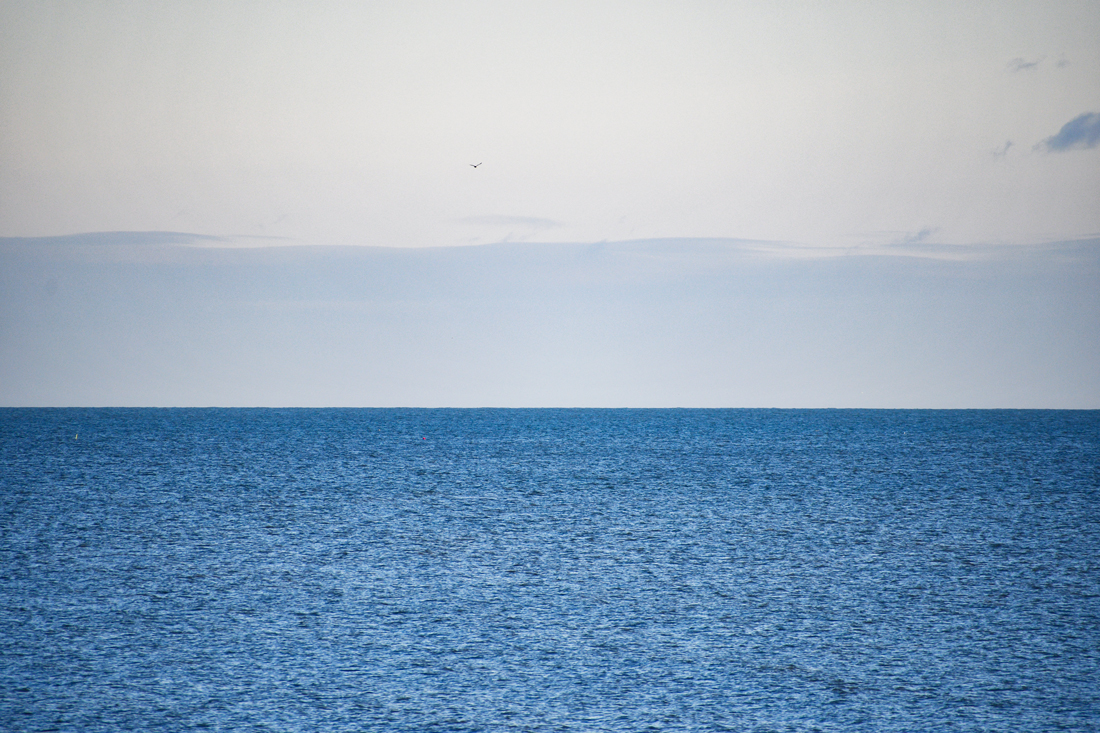
The English Channel from Eastbourne. On the other side is France! © French Moments
In the absence of sandy beaches, holidaymakers appreciate the seaside resort for its sunny climate, its seafront and the many excursions that can be made nearby.
The sun has a date with Eastbourne!
Indeed, the town has the particularity of being sheltered from the west winds by the chalk cliffs of Beachy Head. This allows the seaside resort to benefit from a microclimate that gives it a French Riviera feel in the summer. Not surprisingly, Eastbourne is reputed to be the sunniest town in Britain!

Sunset on Eastbourne beach © French Moments
Finally, the town is an ideal base for walking the cliffs of Beachy Head in the morning before lounging on the beach in the afternoon.
Plan your visit to Eastbourne
Some useful tips and advice for planning your visit to Eastbourne (some links are sponsored).
Getting to know Eastbourne
Eastbourne's attractiveness is demonstrated by the fact that the town's population has grown considerably over the years. The population has grown from 88,000 in 2001 to over 104,000 in 2019.
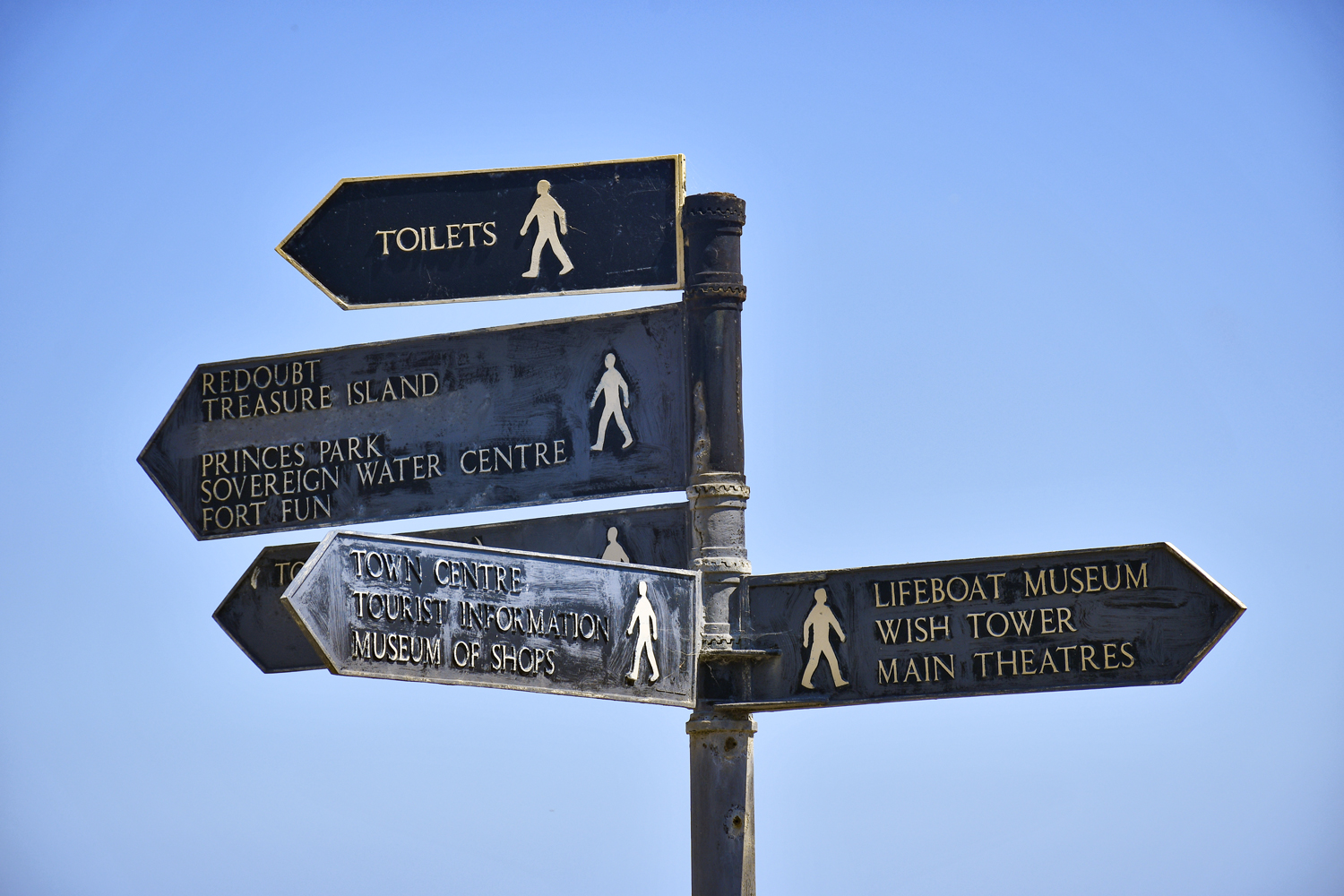
One can't get lost in Eastbourne! © FrenchMoments
Tourists visit two parts of the city:
- The commercial town centre along Terminus Road, between the railway station and Susans Road. The Arndale Shopping Centre plays a key commercial role.
- The five-kilometre long waterfront, famous for its shingle beaches. It consists mainly of Victorian hotels, the Eastbourne Pier, a theatre, a contemporary art gallery, a Napoleonic-era fort and a military museum.
- In addition, Old Town is a small, little-known part of the city with buildings dating back to the Middle Ages.
Crazy facts about Eastbourne!
- The town's population is over 104,000.
- 31.4% of Eastbourne's population is under 30 years old.
- 5,460,000 visitors each year of which 13% are foreigners (pre-Covid)
- According to the Met Office, Eastbourne is the sunniest place in the UK.
- Eastbourne has the only 5* seaside hotel in the UK, the Grand Hotel.
- Claude Debussy wrote "La Mer" while staying at the Grand Hotel in 1905.
- The seafront bandstand is the busiest in the UK.
- With ideal temperatures and limestone soil, East Sussex is an excellent place to produce world-class sparkling wines, which often beat champagne in blind tastings.
- William the Conqueror landed at Pevensey in 1066, now on the outskirts of Eastbourne.
- The first seaplanes were built here in 1912.
- It was the first town to install British-made traffic lights in 1931.
- Sovereign Harbour is the largest artificial marina in Europe.

Sovereign Harbour, the largest artificial marina in Europe © French Moments
A bit of history
In the 18th century Eastbourne consisted of four settlements - East Bourne, South Bourne, Meads and Sea Houses - which made their living from sheep farming and fishing.
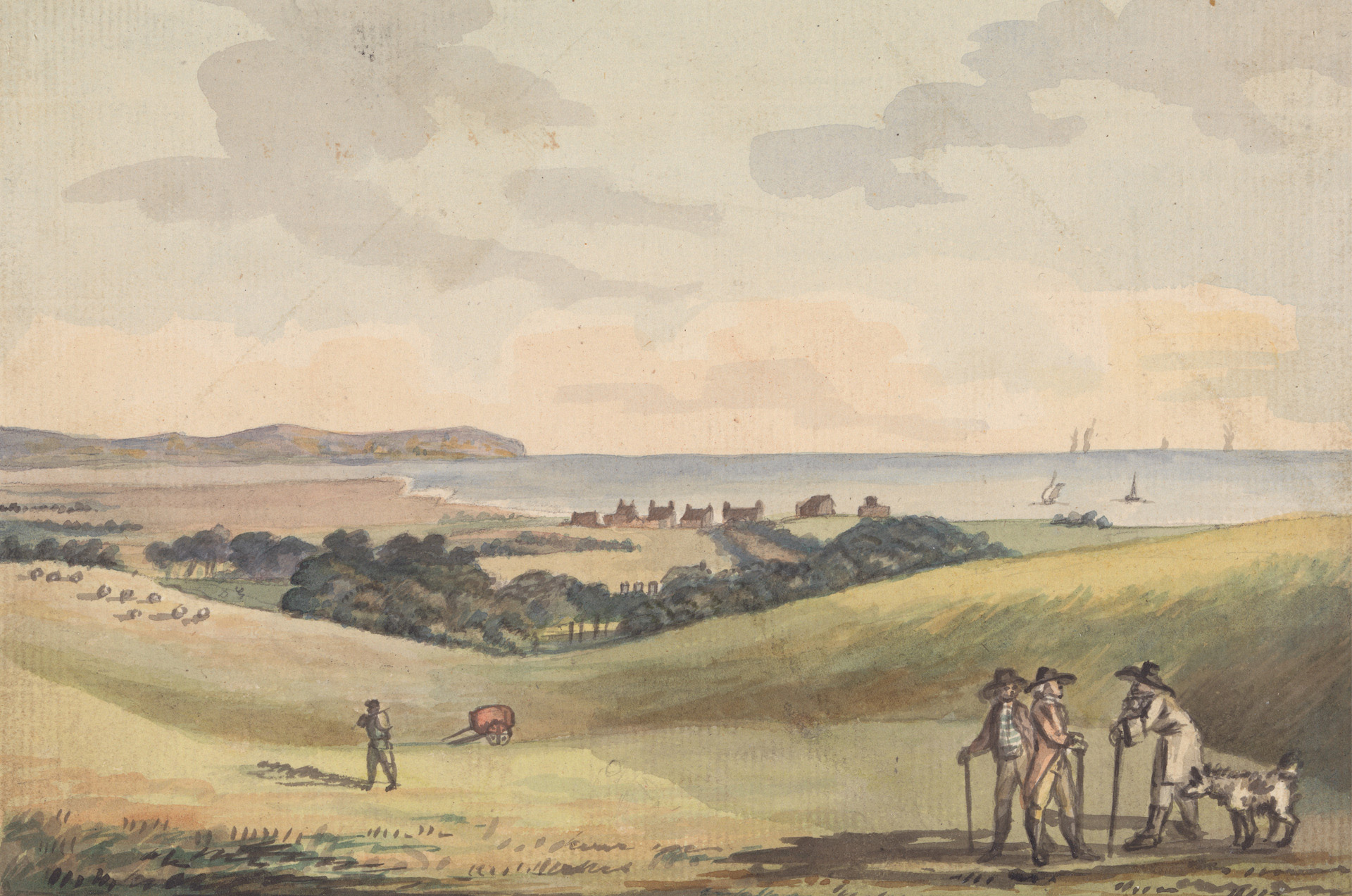
Eastbourne in 1787. Painting by John Nixon
However, as the benefits of swimming and the invigorating sea air were recognised, Eastbourne's potential as a seaside resort for visitors grew.
A princely visit
The children of King George III of England, Princes Edward and Octavius, and Princesses Elizabeth and Sophia, holidayed there in 1780, which added to its appeal.

The three youngest daughters of King George III. Painting by John Singleton Copley (1785)
A resort for gentlemen by gentlemen
The town developed slowly during the first half of the 19th century until the intervention of William Cavendish (1808-1891), Earl of Burlington and the leading local landowner. The future Duke of Devonshire embarked on a building programme to create a resort for social visitors.
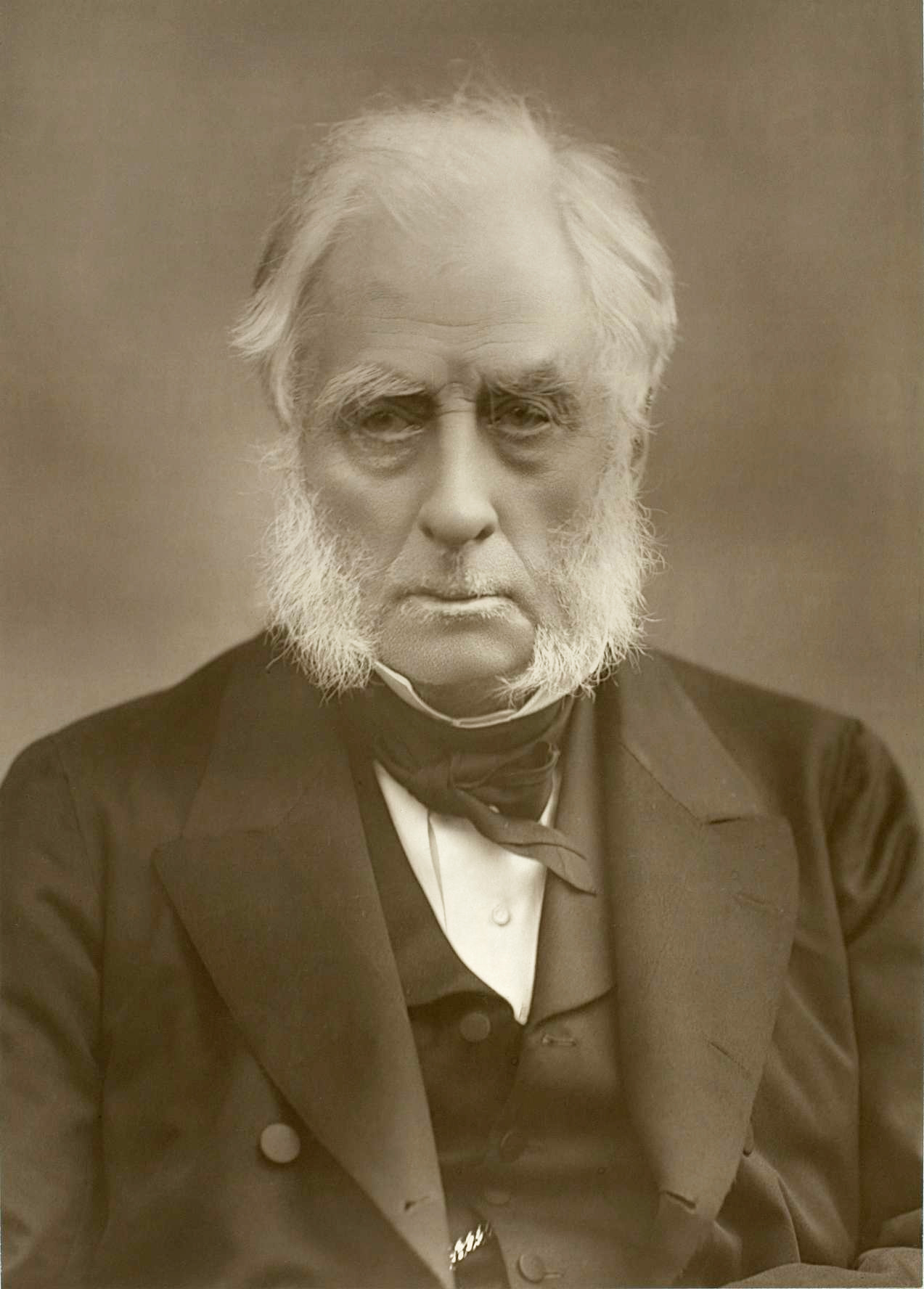
Photo of William Cavendish, 7th Duke of Devonshire in 1880s.
The count invested 37,000 pounds in the construction of a dike and a promenade. The construction of elegant buildings and houses began immediately. The development of the town was slow, however, until the arrival of the railway in 1849, which made the town more accessible to visitors.
In 1859, the Duke dispensed with his original architect, James Berry, and engaged a new agent, Henry Currey, to draw up the plan for what was in effect a new town. A seaside resort built 'for gentlemen by gentlemen'.
The town's population increased tenfold in forty years, from about 3,400 in 1851 to nearly 35,000 in 1891.
The city of appearances
For the first visitors who spent a 'season' in Eastbourne, the town was a place to be seen.
One of the town's earliest newspapers was called "The Eastbourne Gazette and Fashionable Visitors List". Anyone who wished to advertise their presence was listed on the front page as a resident for the week!
A seaside resort that also attracts miscreants
Before the First World War, workers had no legal right to a holiday. However, the practice of planned mass absence from work developed in England from the 1880s, with people taking unofficial holidays. Visitors flocked from the cities to the seaside resorts, aided by cheap train tickets.
This was a real problem for Eastbourne, which focused on catering for an exclusive upper class clientele. Lower class tourists were lowering the bar - they were simply not wanted.
How to prevent miscreants from coming...
In the 1890s the council twice tried to persuade the railway companies not to sell cheap tickets from London in order to keep out the riff-raff.
These attempts were unsuccessful as they would have been illegal.
It was also suggested, but not pursued, that a branch line be built to a station in the east of the city. The idea was to keep the lower classes out of the better areas.
Circumstances changed in the 1920s and 1930s, when huge crowds flocked to the city. However, the need to stand out from the crowd remained permeated in the life of the city.
Where to stay in Eastbourne?
Browse the map below to find accommodation in the resort. Or click on this link for a list generated by Booking.com.
The sea front
Eastbourne offers over 3 miles of extensive shingle beaches.
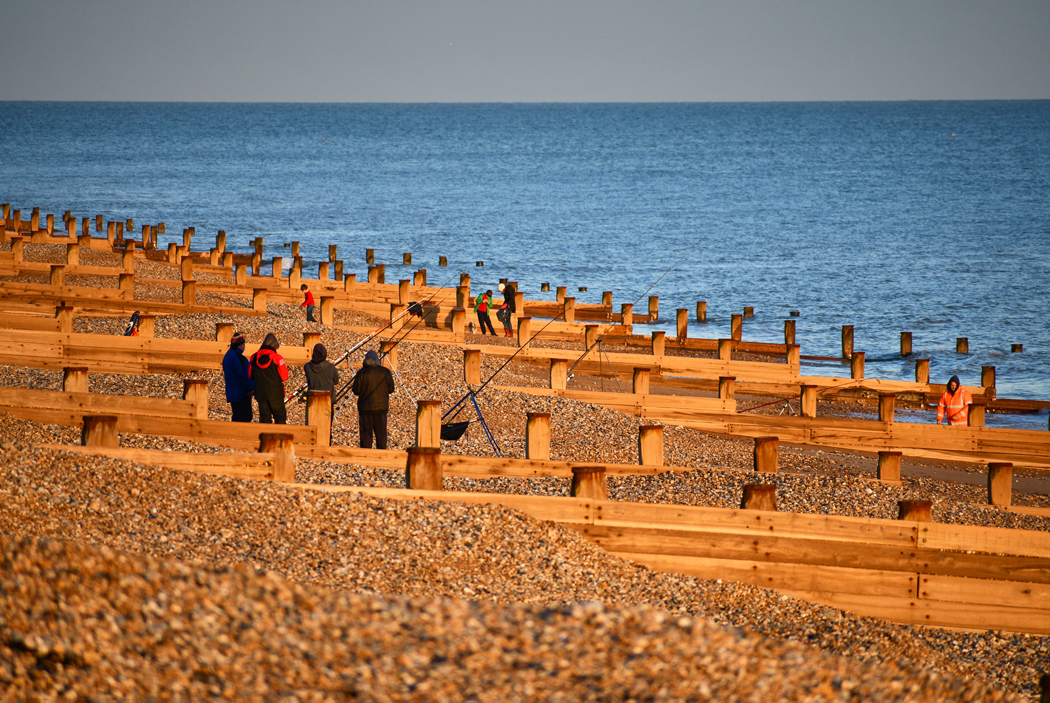
Low light on Eastbourne beach © French Moments
The Eastbourne Pier marks an urban change in the history of waterfront development in the second half of the 19th century:
- to the west of the pier are high class hotels
- to the east of the pier, the waterfront comprises modest family hotels and boarding houses.
The tour begins in the east with the Eastbourne Redoubt.
Eastbourne Redoubt
Eastbourne Redoubt is a circular coastal defence fort which lies to the east of the pier at Royal Parade.
Its construction dates from 1804-1810, during the Napoleonic Wars. The fort was part of the Martello Towers defence system set up to counter the threat of invasion by Napoleon.
A true barracks, the fort also included a supply depot and 10 cannons.
Used by the military during the First World War and then requisitioned during the Second World War, the redoubt is now home to the largest military museum in the South East of England.
Eastbourne Pier
The English are fond of these promenade piers, which were created as places of entertainment for walkers or tourists in seaside resorts. As in Brighton and Bournemouth, Eastbourne Pier is no exception and is part of the local landscape.
It is one of the finest examples of a Victorian pier and is a major landmark on Eastbourne's seafront.
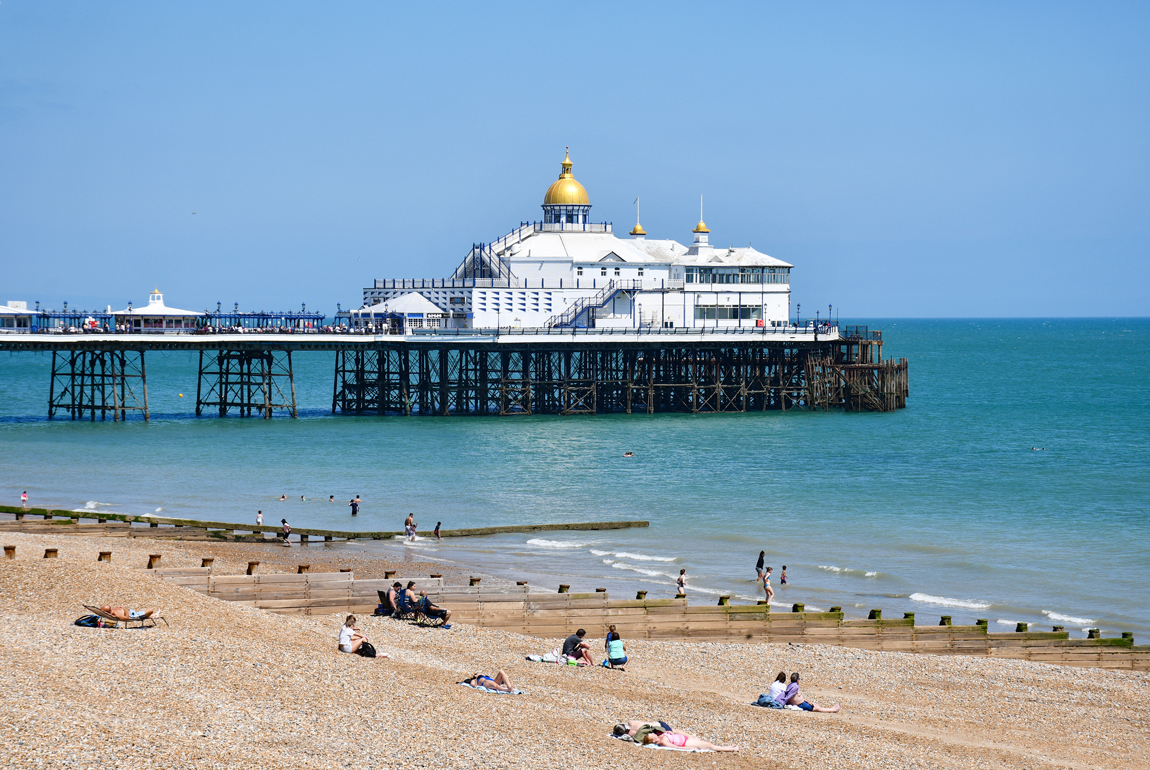
The Eastbourne Pier, the seafront landmark © French Moments
The pier: physical and social boundary
In the late Victorian era, this point on Eastbourne's waterfront was effectively a boundary, both physical and social.
The beautiful villas and terraces designed for fashionable visitors were to the west of the pier.
To the east were the houses of fishermen, shopkeepers, craftsmen and domestic staff who helped to ensure the comfort of those who enjoyed the refined charms of the seaside resort.

The Queens Hotel and the eastern seafront of Eastbourne © French Moments
"Never east of the pier, dear!"
It was said that if a lady asked for advice on the best place to stay for a stay in Eastbourne, the experienced visitor's answer was: "Never east of the pier, my dear".
A Roman villa hidden at the entrance to the pier
The history of this part of the promenade goes back much further than the construction of the pier and the imposing Queens Hotel.
Few people know that beneath the causeway opposite the pier are the remains of a Roman villa dating from the early Roman occupation of Britain.
A Roman causeway and baths were discovered during excavations in 1717 and again in 1841.
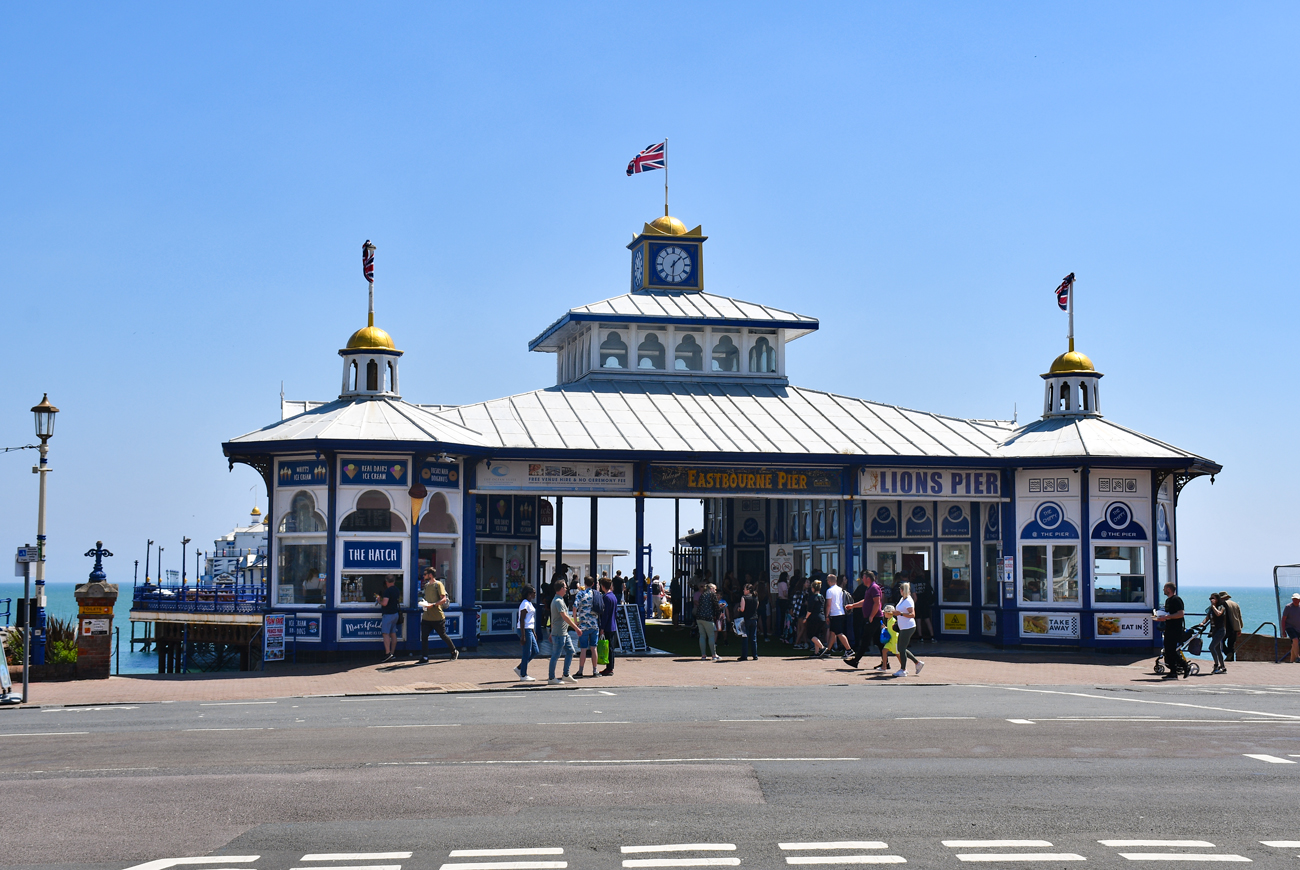
The entrance to Eastbourne Pier. This is where the remains of a Roman villa were found © French Moments
Size of the pier
The pier is 300 metres long and is built on wooden stilts, which rest in cups on the seabed, allowing the whole structure to move in heavy weather.
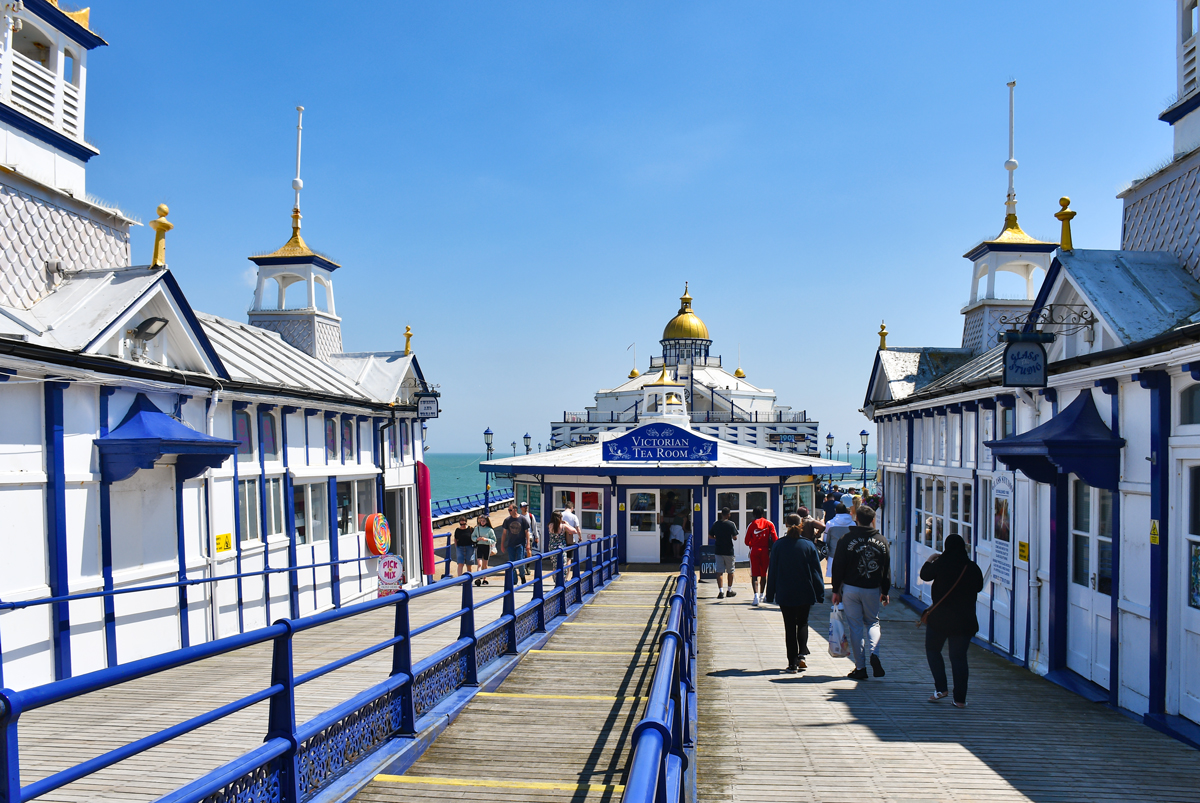
Stroll around Eastbourne Pier © French Moments
A leisure facility
The Pier is a leisure facility. It has a small variety of shops, cafes and restaurants, a Victorian tea room and a nightclub... not to mention the slot machines in the gaming rooms!
It offers beautiful views of the English Channel and the seafront.

The view of the resort from the end of the pier © French Moments
Eastbourne Pier was opened in 1870 by Lord Edward Cavendish, two years before its completion.
Maritime connections with France from the pier!
Paddle steamers operated by P and A Campbell ran trips from the pier along the south coast and across the Channel to Boulogne-sur-Mer.
The service ran from 1906 until the outbreak of the Second World War. These trips resumed after the war, but the paddle steamers were gradually withdrawn from service. In 1957, the last season was operated by the motor vessel "Crested Eagle".
The Eastbourne Pier fire of 2014
The pier suffered a fire on 30 July 2014 which destroyed much of the central domed building.
East Sussex Fire and Rescue Service deployed up to 80 officers to tackle the fire, which is believed to have started in the woodwork of the arcade walls.
After fighting the fire through the night, firefighters cleared the main hotspots and saved two thirds of the pier.
The outer pavilion was unaffected by the fire, which broke out two weeks before Eastbourne's biggest waterfront tourist event, the Airbourne air show.
Grand Parade
Grand Parade is the waterfront avenue that runs from the pier to the Wish Tower and past the bandstand. During the summer season, the lively avenue takes on a French Riviera feel with its almost Mediterranean vegetation!
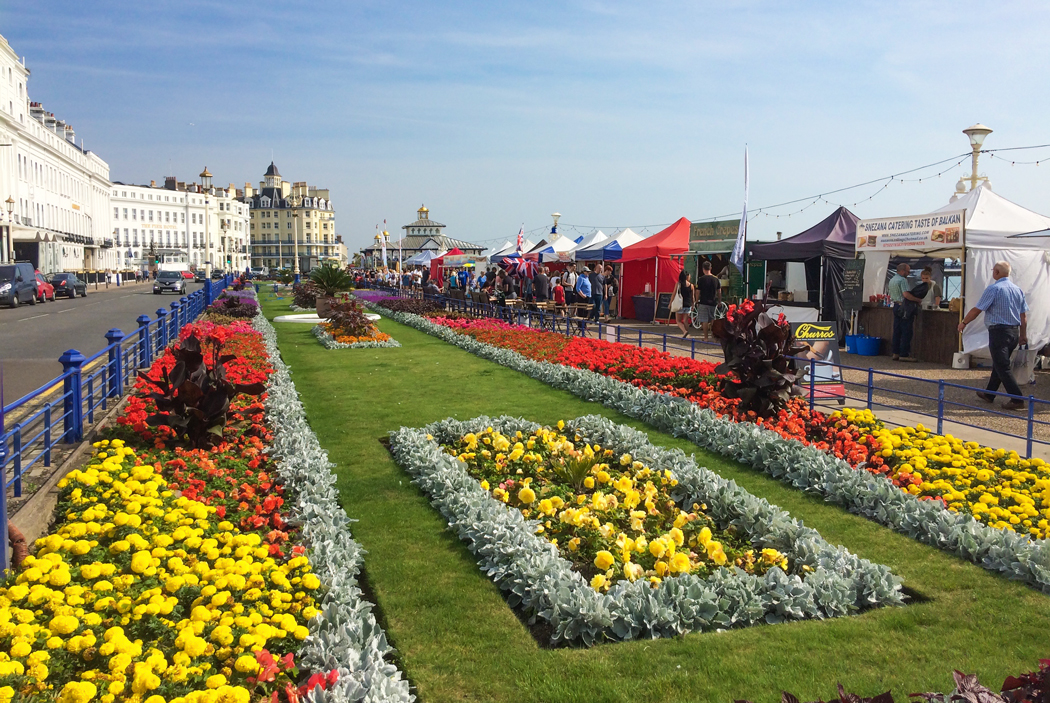
Flower display on Grand Parade © French Moments
The thoroughfare is lined below by Eastbourne Parade which runs along the shingle beach.
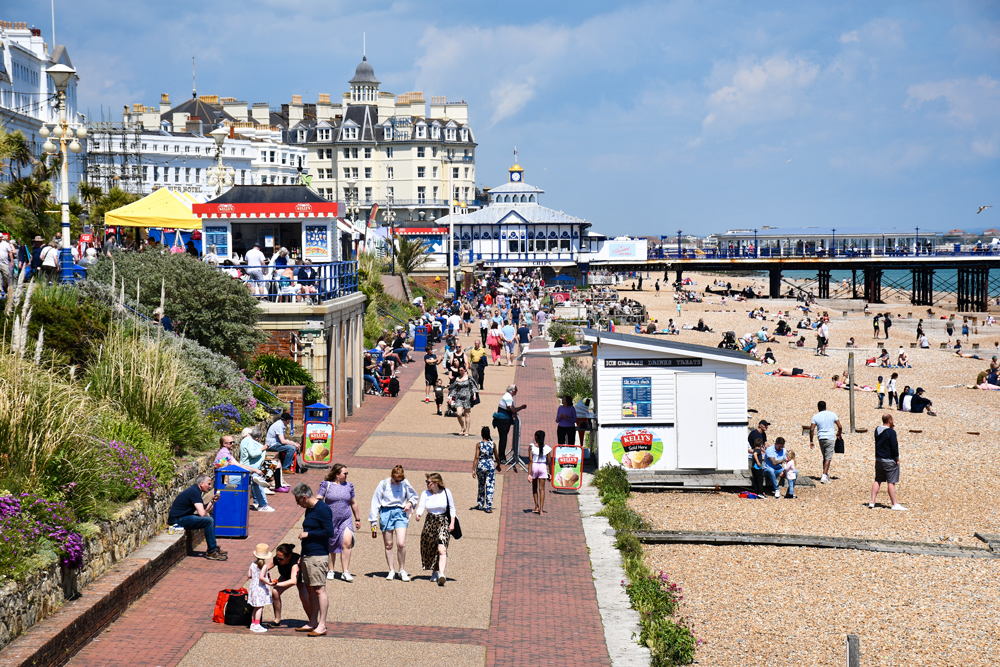
The Eastbourne Parade route runs along the beach to the west of the resort © French Moments
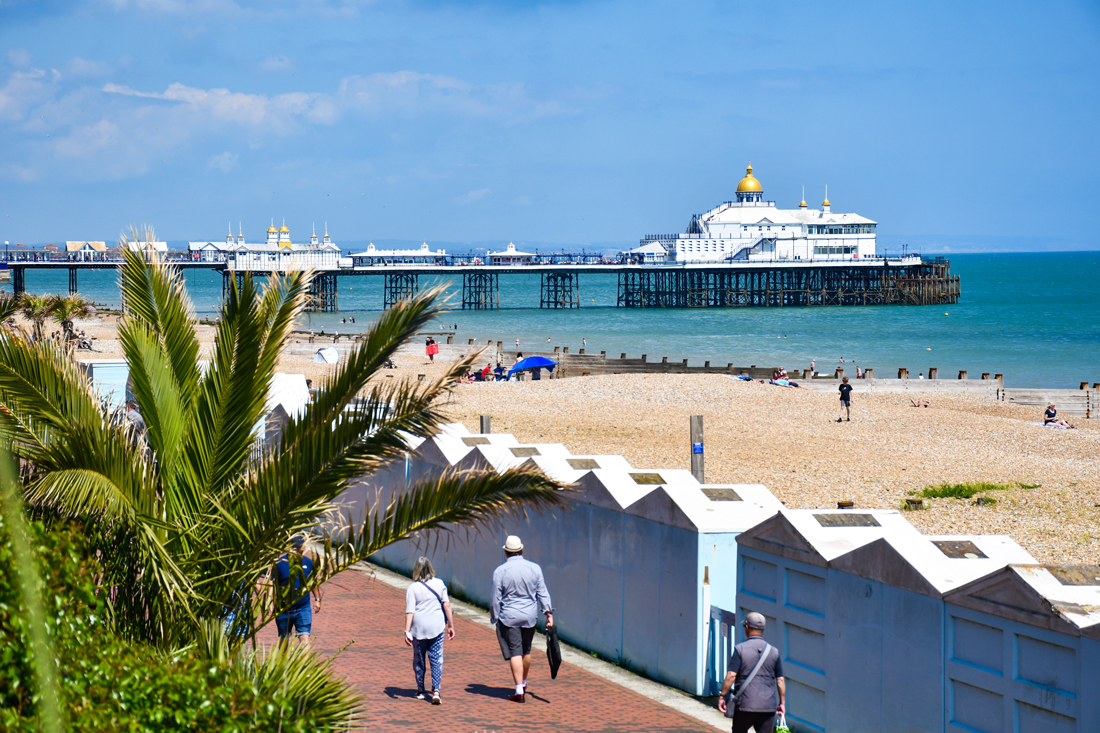
Eastbourne Parade © French Moments
The Bandstand
The present bandstand dates from 1935. Its construction was part of the main development of the waterfront.
It is unique in the country with its neo-Greek design, semi-circular shape and blue dome.
The kiosk is surrounded by a long colonnade clad in different coloured earthenware. The columns are of Tuscan and composite order.
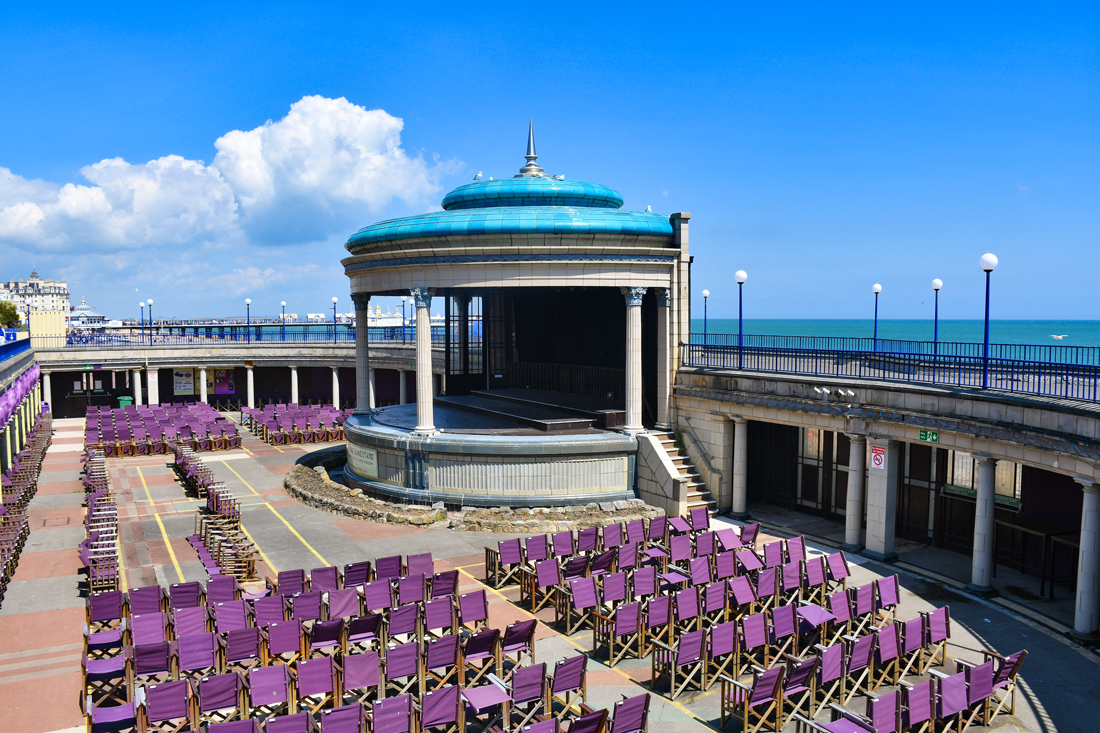
The Eastbourne bandstand © French Moments
A unique facility in England
The complex has a main arena, middle and upper balconies and seats 1,400 people.
As a result, the bandstand is now the busiest in the UK. It offers a variety of live musical entertainment with over 140 events each year, from tribute shows to concerts, fireworks and children's entertainment.
Remembering the Titanic
Opposite the bandstand, in the main arena, is a plaque commemorating local musician John Wesley Woodward. He was part of the band that played on the Titanic when it sank on 15 April 1912.
Wish Tower
Built in 1806, the Wish Tower is contemporary with the other two Martello Towers in Eastbourne and the Redoubt Fort.
It is a circular tower with 2.4m thick cement-lined walls and a raised entrance.
The sturdy fort's role was to defend the surrounding area against Napoleonic invasion. Fortunately, it was never used in a conflict against Napoleon, nor during the two world wars.
The tower was reinforced during the Second World War by the addition of a projecting lookout post.

The Wish Tower © French Moments
Peace Garden
This peaceful circular recess is located in what was once the moat of the Wish Tower.
Eastbourne suffered severe aerial bombing during the Second World War. The civilian war memorial plaque lists the names of those who lost their lives.

The World War II civilian memorial plaque in the peace garden © French Moments
The garden is a relaxing place where you can enjoy the floral display and the Mediterranean vegetation.
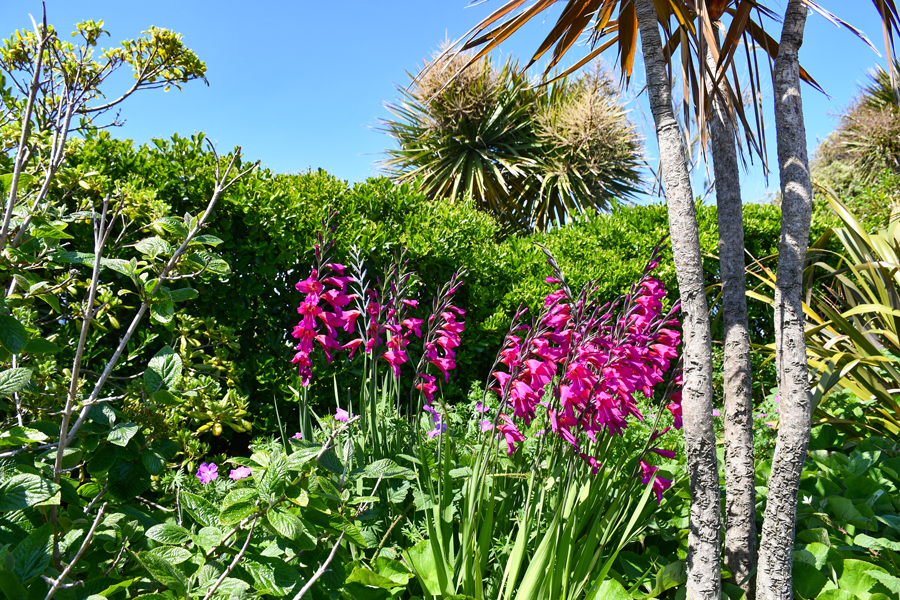
The Peace Garden © French Moments
The Wish Tower stands at the top of an eminence: Wishtower Slopes. It offers a beautiful view of the waterfront and Eastbourne Pier.
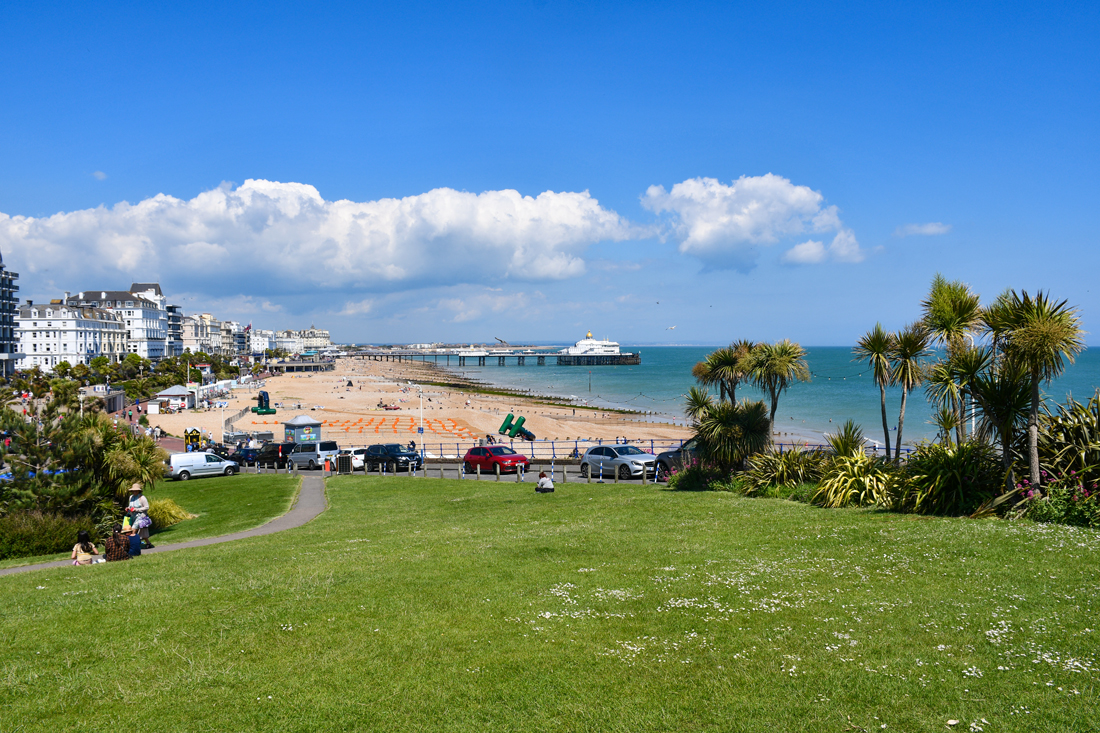
The view of the waterfront from Wishtower slopes © French Moments
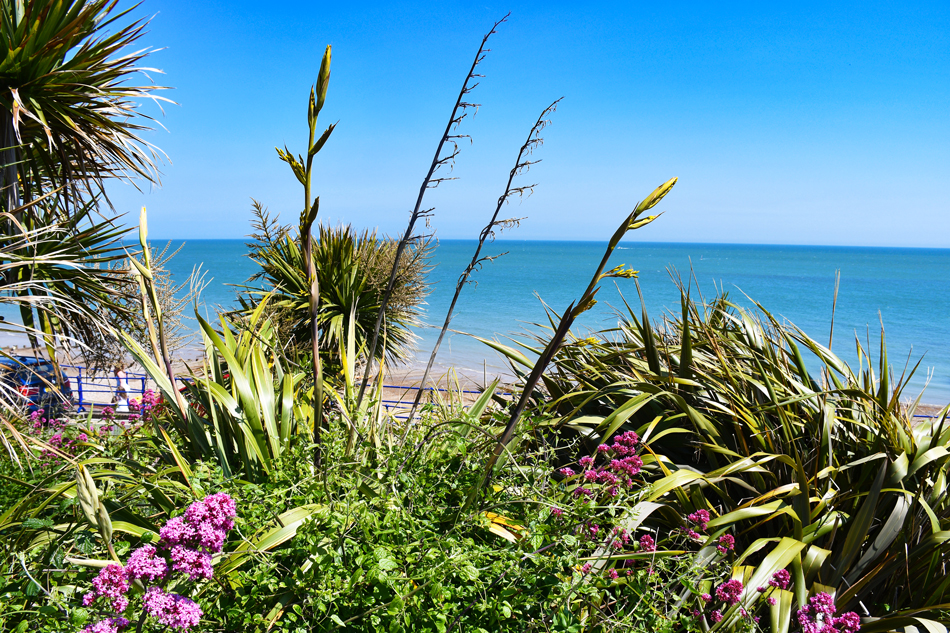
Lush vegetation at Wishtower slopes © French Moments
Right next door is the Bistrot Pierre with its magnificent view of the sea. Yes, for a short while, it feels like the French Riviera!
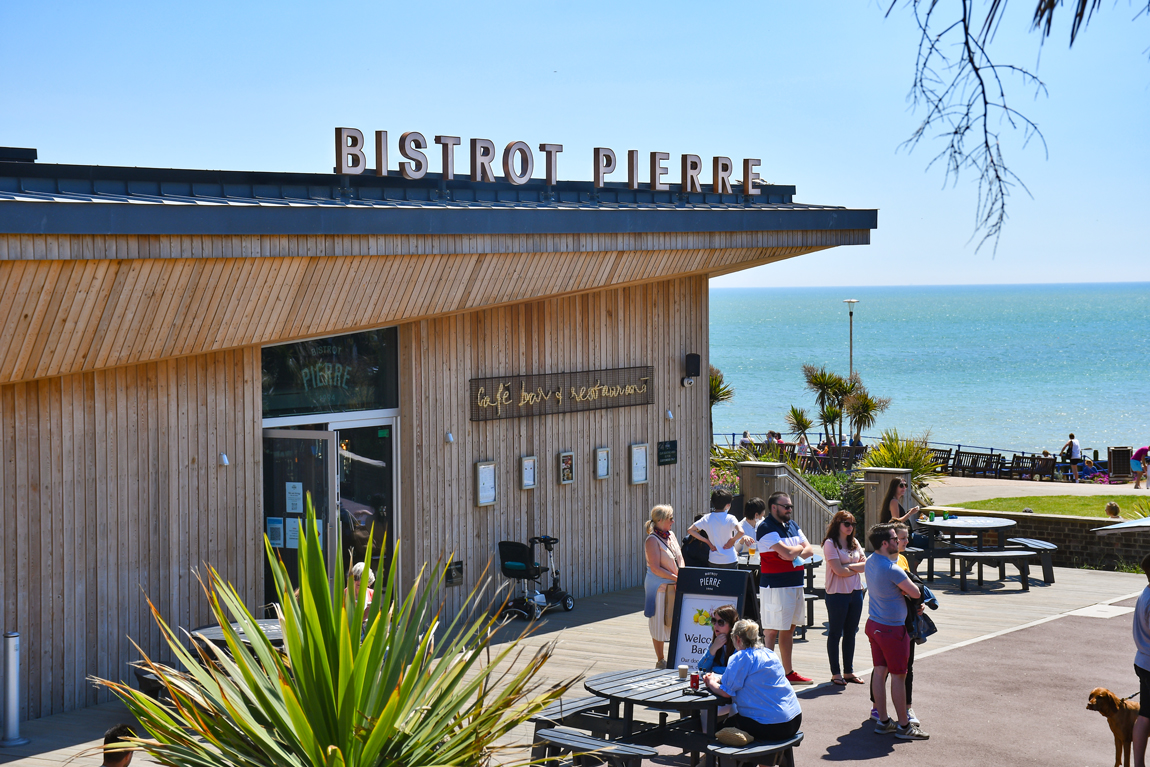
The Bistrot Pierre overlooking the sea © French Moments
The lawns of Western Lawns host a Ferris wheel in the summer months, adding to Eastbourne's festive atmosphere.
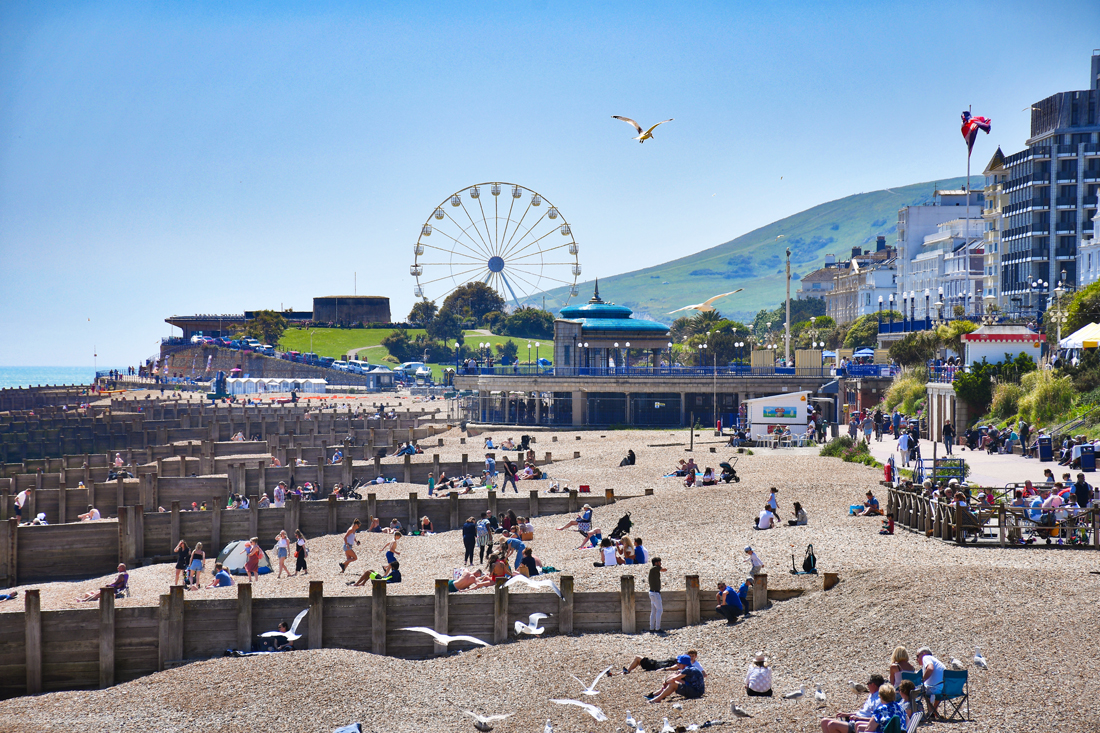
Eastbourne beach west of the pier: the bandstand, Wishtower slopes, Wish Tower and Ferris wheel. In the background, the hills of Beachy Head © French Moments
Meads and Holywell Retreat
The area to the west of the Wish Tower is called Meads. It is a leafy, wealthy area with high quality houses and buildings. At the far end of King Edwards' Parade is Holywell Retreat.
The location is named after the former fishing hamlet of Holywell. This was situated close to the cliffs on a ledge about 400 metres southwest of the public garden known as Holywell Retreat.
Sheltered by the South Downs which flow into the sea, the area is graced by a popular café, cabins and beach cottages.
This stretch of coastline offers rock pools at low tide, pretty Italian gardens and views of the spectacular chalk cliffs of Beachy Head.
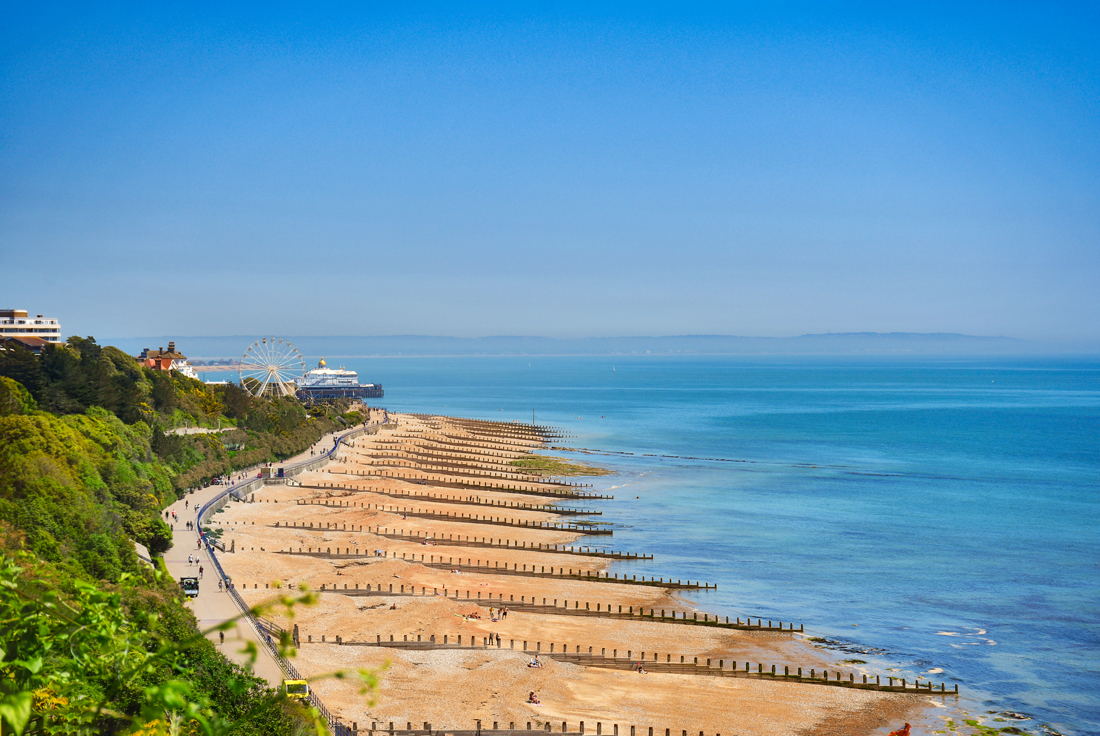
The view from the cliff of Holywell © French Moments
Holywell Retreat: a film location
Holywell and the surrounding pebble beach have been used as the setting for films and TV series: BBC's EastEnders, Miss Marple, and Phill Collins' 'You'll be in my Heart' video.
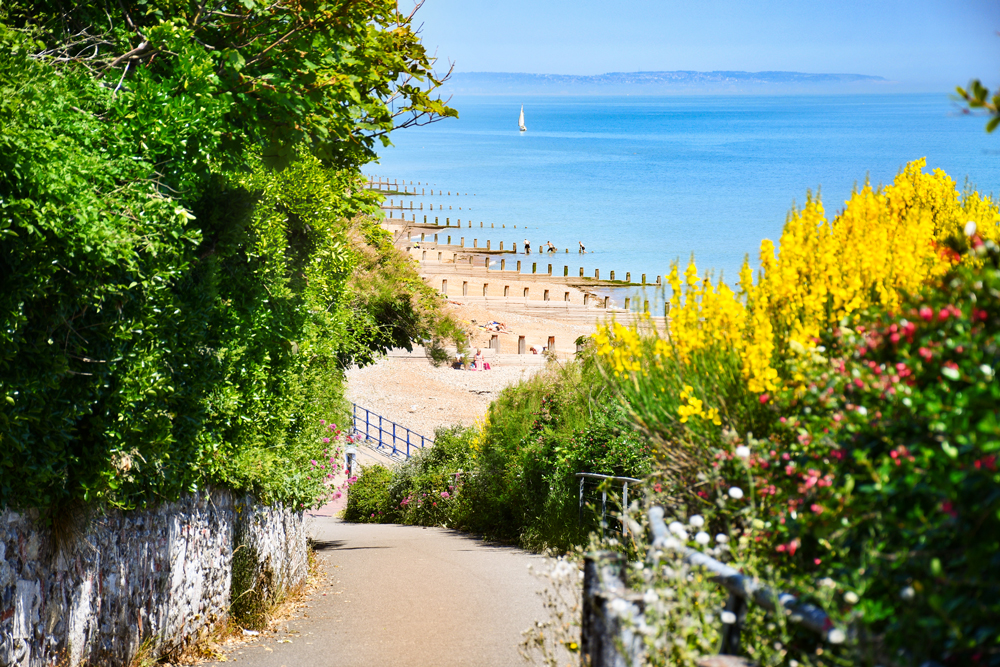
Descent to Holywell beach © French Moments
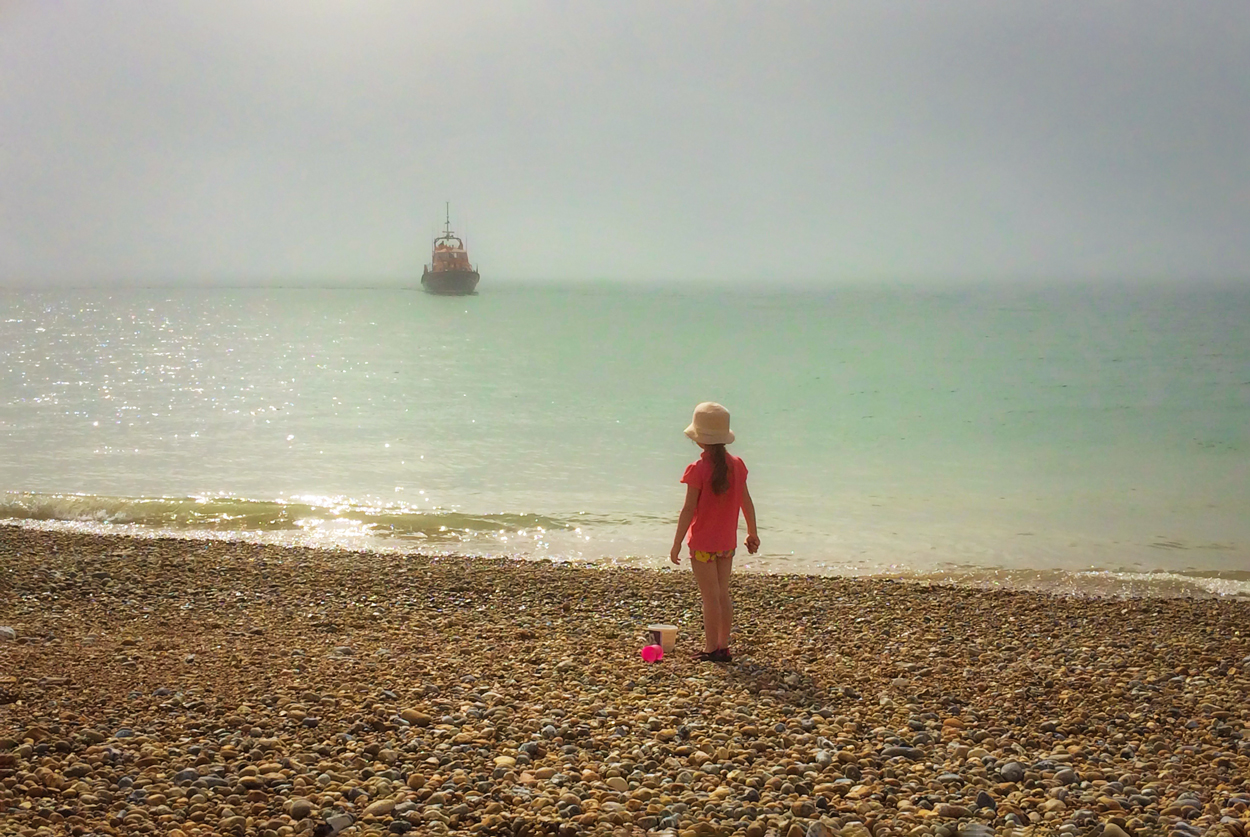
On the beach at Eastbourne © French Moments
The shopping city
Eastbourne's shopping town centre is not particularly interesting for tourists - unless you're into shopping!
There are a few places that deserve a mention...
The Railway station
Any traveller arriving in Eastbourne by train must see the station from the outside.
Unlike other English towns where the original building has unfortunately been destroyed to make way for an ugly modern building, Eastbourne has managed to preserve its 19th century station.
The 1861 yellow brick railway terminus has a French pavilion roof and various medieval features.
The station is dominated by a clock tower with a steep pyramidal roof standing at the junction of the two main streets. The glazed canopies are original.
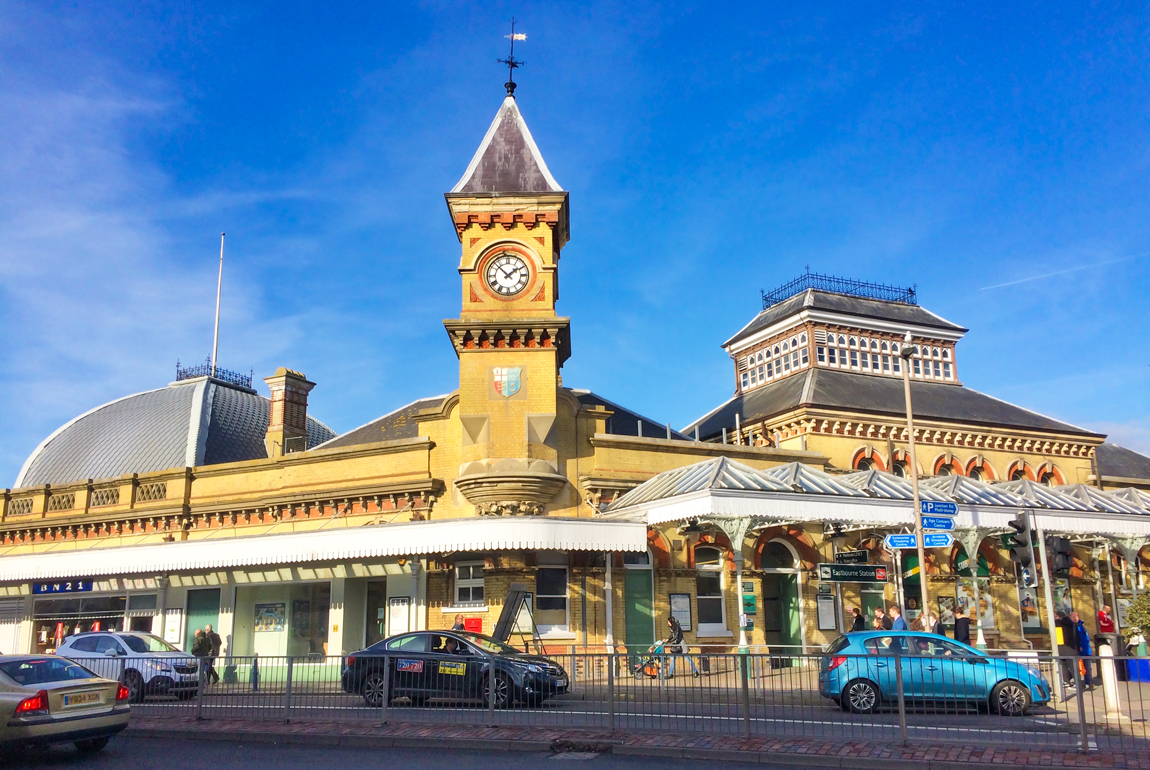
The Eastbourne railway station © French Moments
The picturesque streets of the Victorian city
The architecture of some of the town's streets tells the story of Eastbourne's Victorian history: neo-Gothic red brick facades, Regency-style bow windows, Italianate stucco buildings...
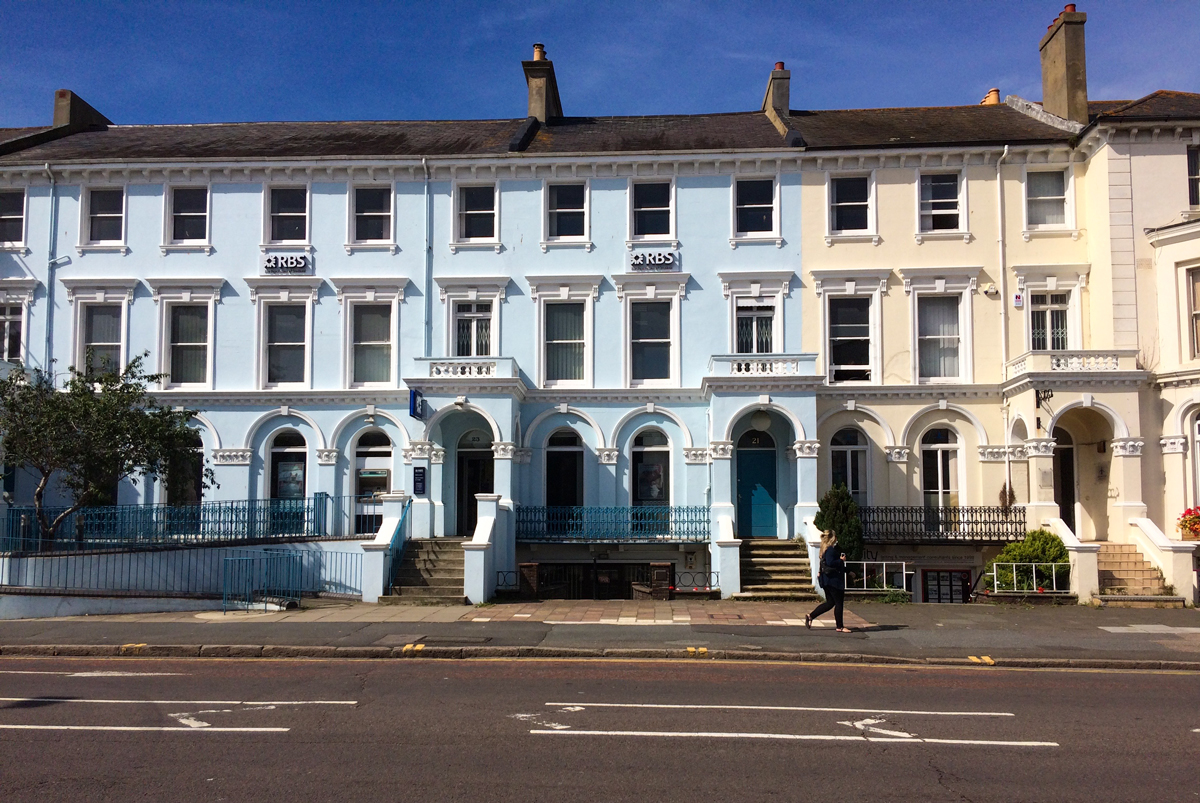
Façades in Eastbourne © French Moments
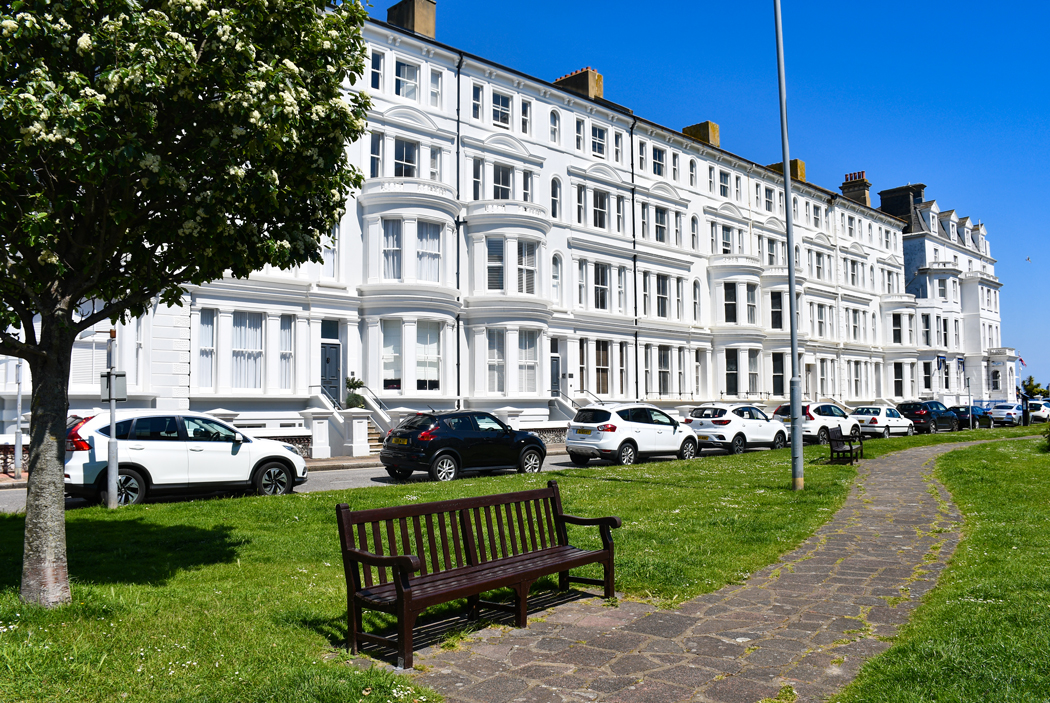
Wilmington Square © French Moments
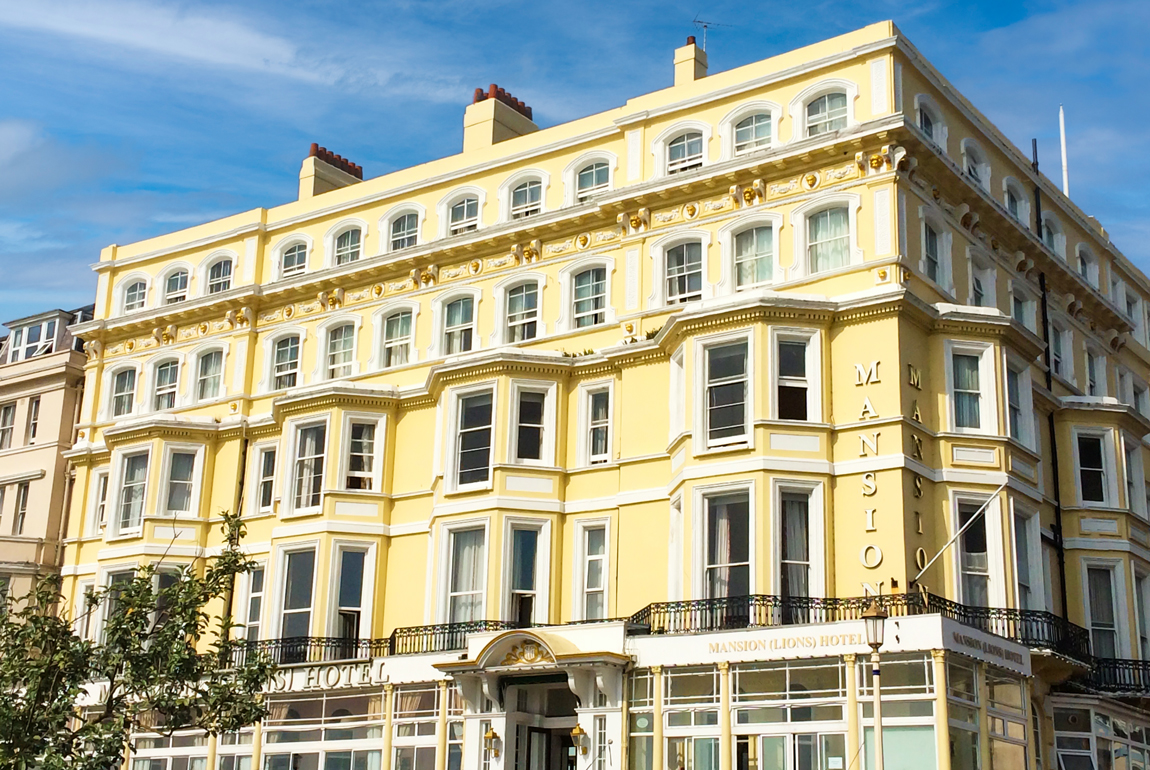
Mansion Hotel © French Moments
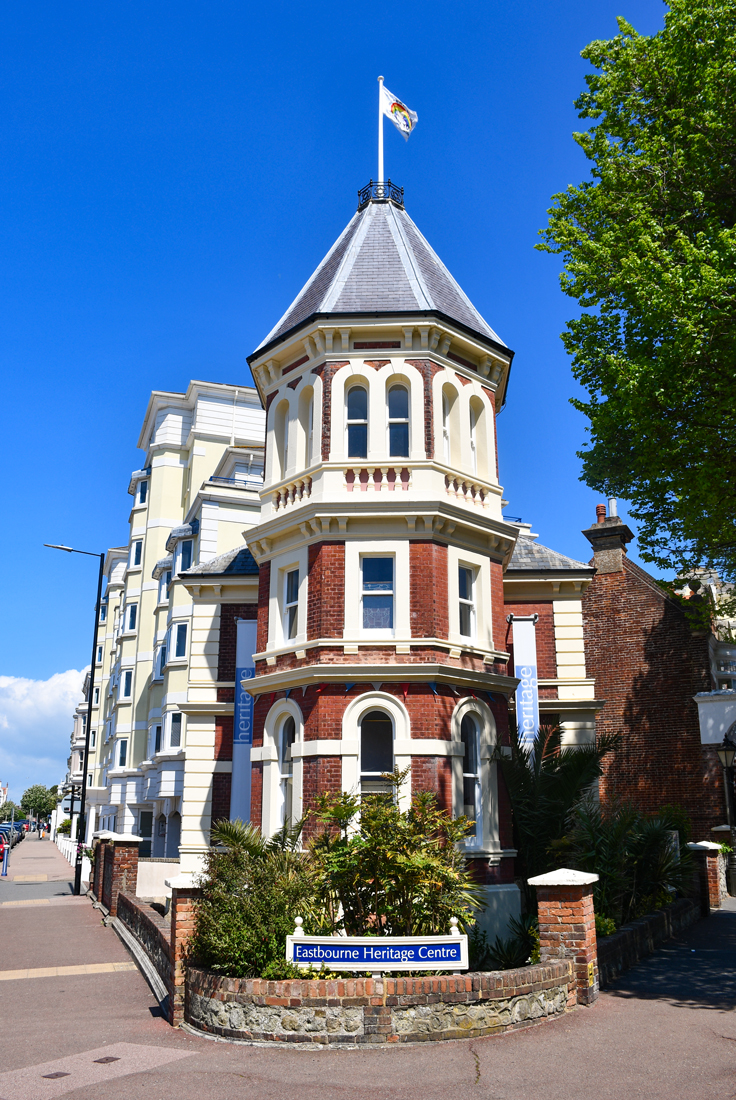
Eastbourne Heritage Centre, Compton St. © French Moments
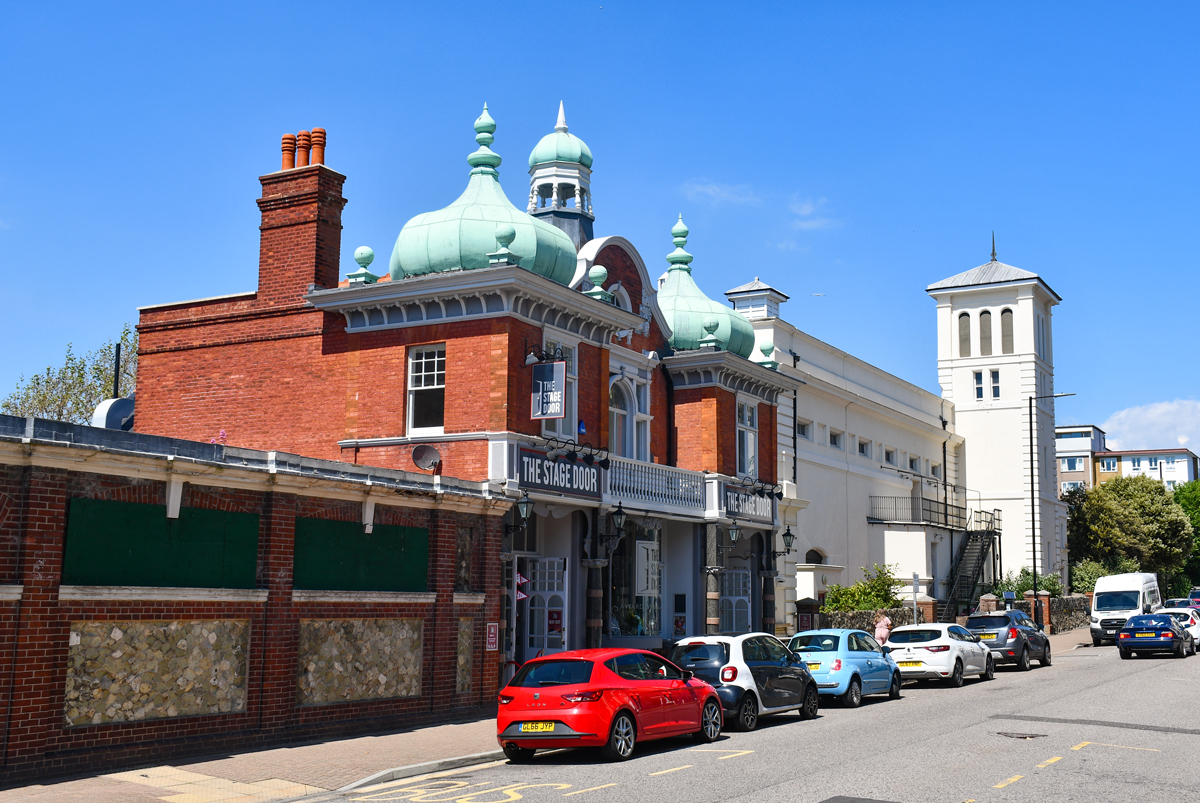
Devonshire Park Theatre © French Moments
Take a stroll along the following streets to see for yourself:
- Grove Road
- South Street
- Seaside Road
- Devonshire Place
- Howard Square
In South Street and Seaside Road there is a row of shop fronts with elaborate gables (and unfortunately in a poor state of repair in Seaside Rd).
This is the Norman Shavian-style, named after Richard Norman Shaw (1831-1912), who is considered one of Britain's greatest architects.
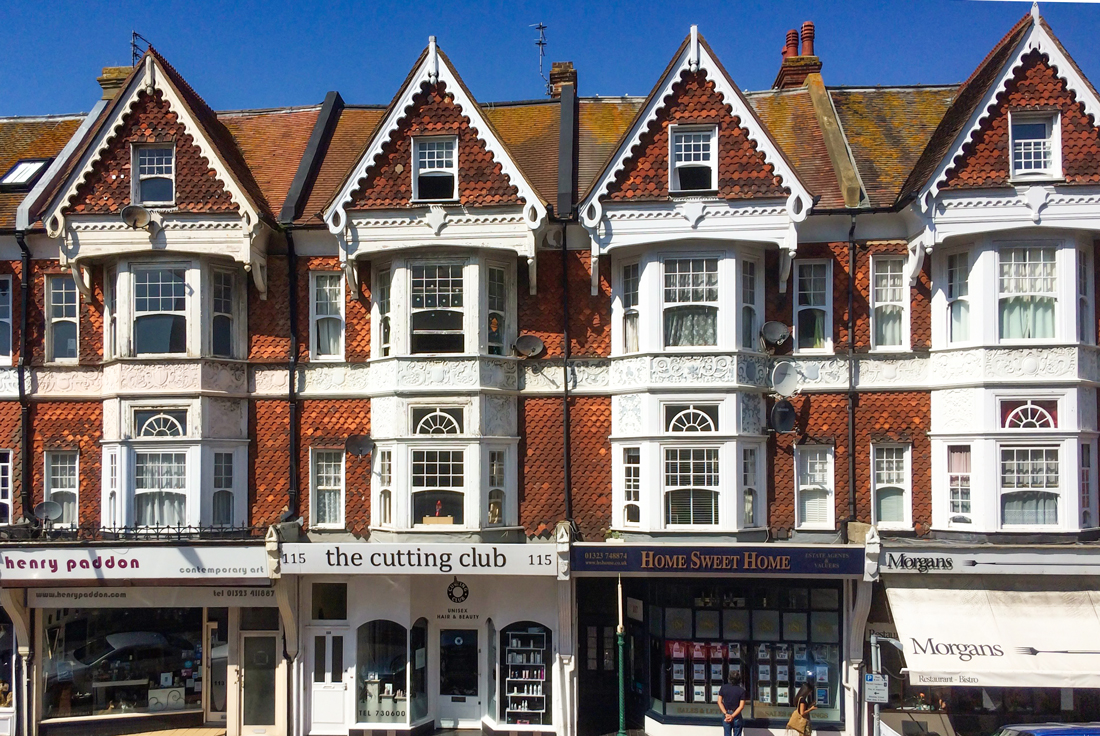
Façades in South Street © French Moments
Old Town district
Eastbourne was formed by the amalgamation of four agricultural hamlets in Victorian times.
The main village was Bourne (later known as Old Town), which contains the parish church of St. Mary the Virgin and a collection of buildings dating from medieval times to the 18th century.
Old Town: Eastbourne's little-known old town
The area known as "Old Town" is the oldest village in Eastbourne.
It is largely unknown to tourists who come to enjoy the seafront and shingle beaches.
The Old Town lies to the north west of the town centre, along High Street and at the site of Eastbourne's Waitrose supermarket.
It's not very big and you won't need to spend hours there!
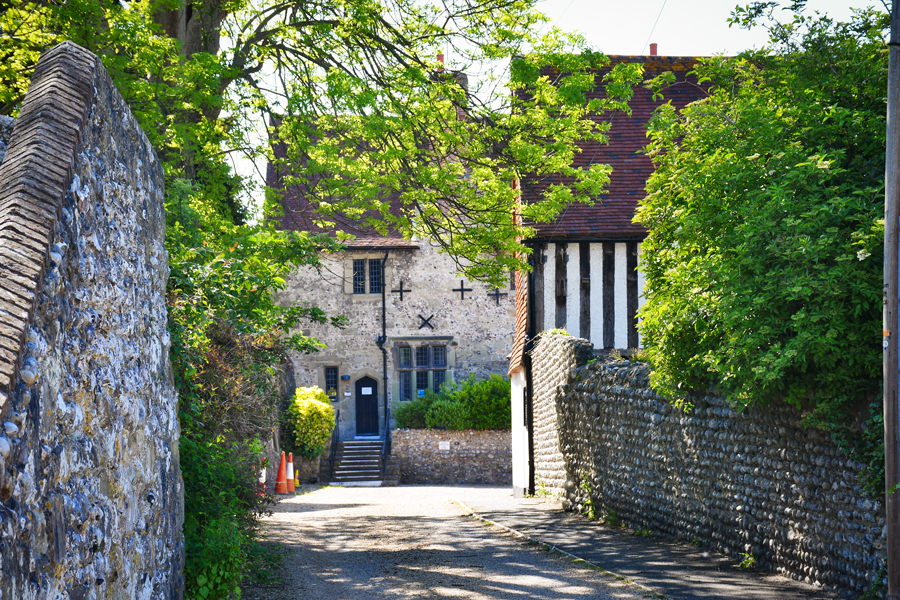
In the Old Town of Eastbourne © French Moments
The most interesting buildings are:
St. Mary the Virgin’s church
The old parish church dates back to the 12th century and was completed in 1500.
The restoration in 1851 did not change much of the exterior: a large building of ashlar and flint with a high, square, crenellated sandstone west tower.
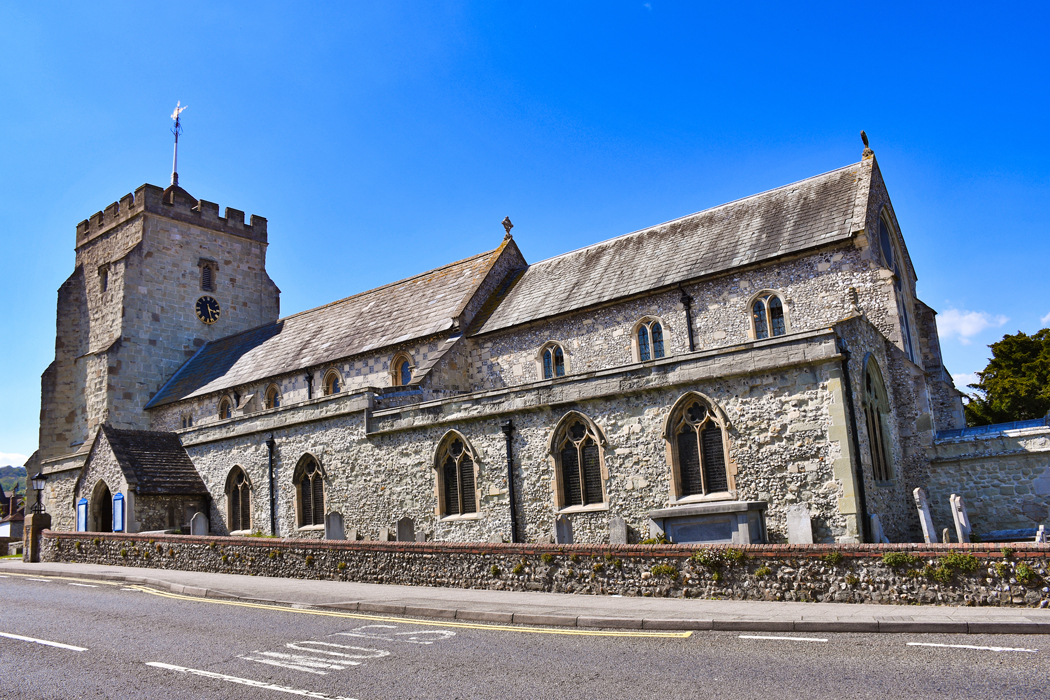
St. Mary the Virgin church by High Street © French Moments

The church tower-porch © French Moments
The four-bay arcades with alternating pillar patterns date from the early 13th century. Some elements of Norman origin also remain in the interior.
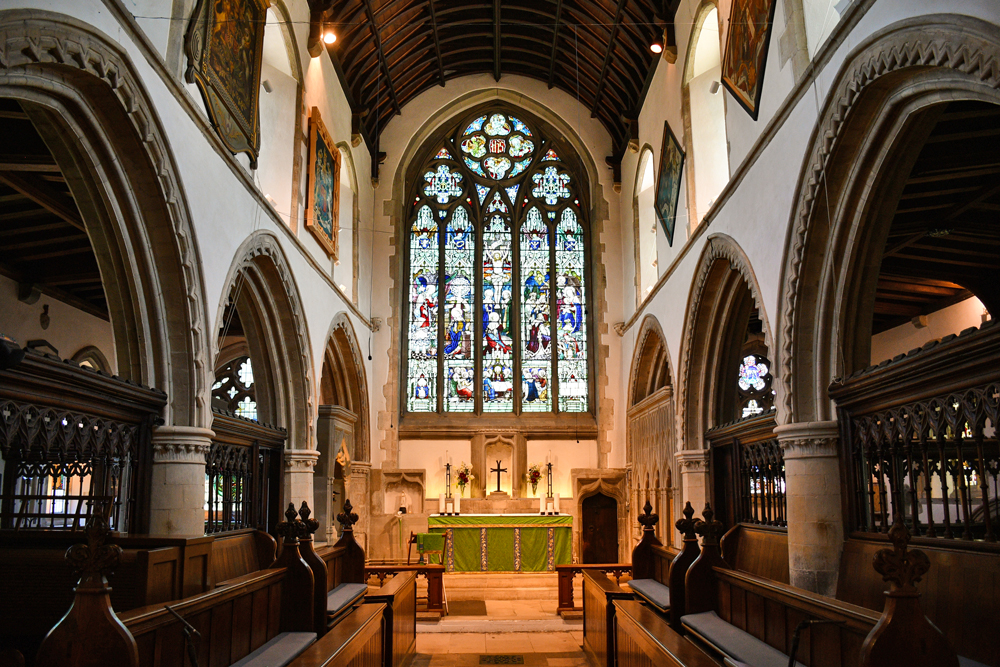
The nave of the St. Mary the Virgin church © French Moments
The oak partitions in the south chapel date from 1315-50 and are among the most splendid in southern England.
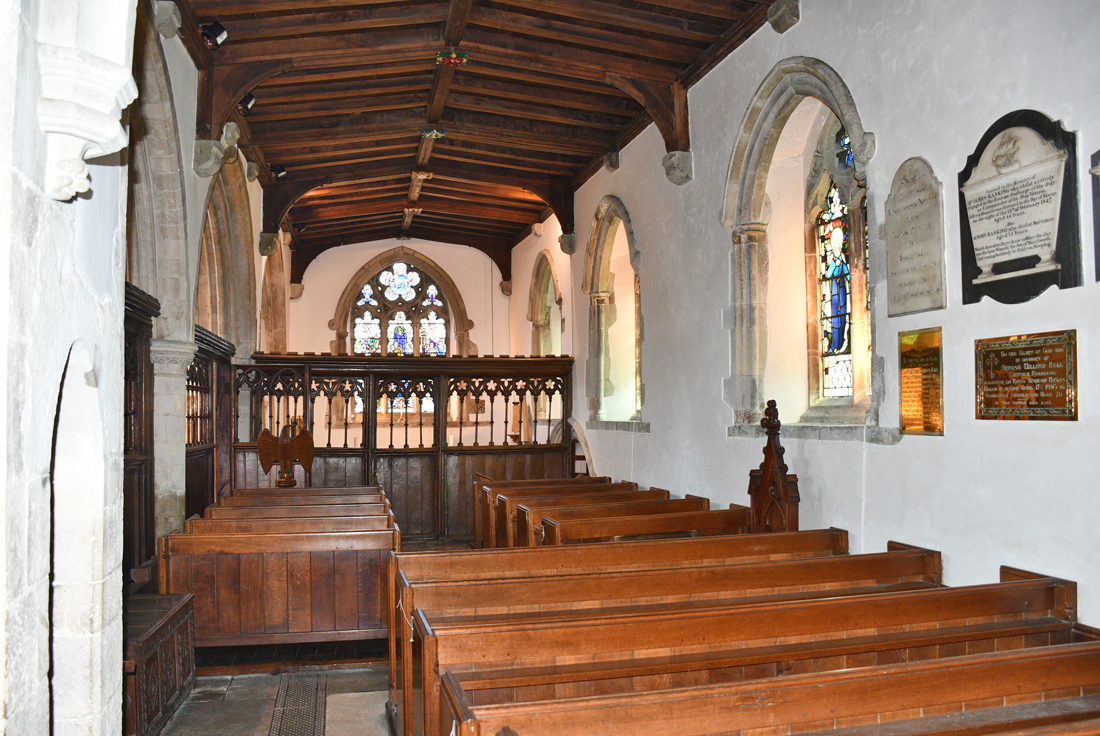
Chapel of the church of St. Mary the Virgin © French Moments
An old cemetery surrounds the church.
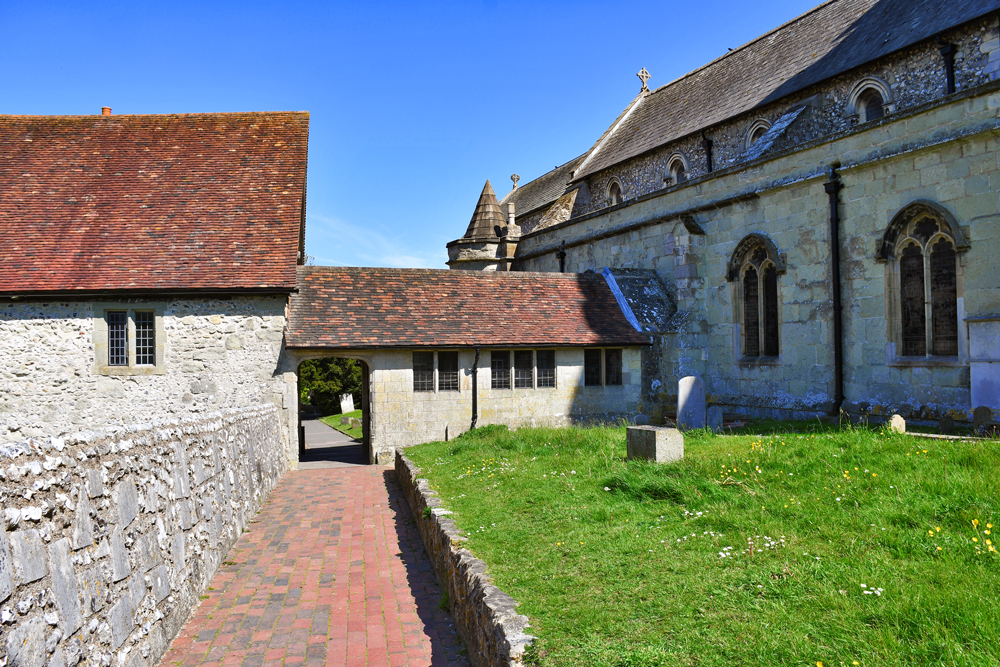
The old parish churchyard © French Moments

In the old churchyard in Eastbourne's Old Town © French Moments
Old Parsonage Barn
The barn stands in the grounds of the former rectory, and was originally associated with it.
New windows have been inserted and a garage built into the east elevation, but the structure and appearance are largely 16th century: the original timber frame remains, and the upper floor is corbelled.

The barn of the former presbytery © French Moments
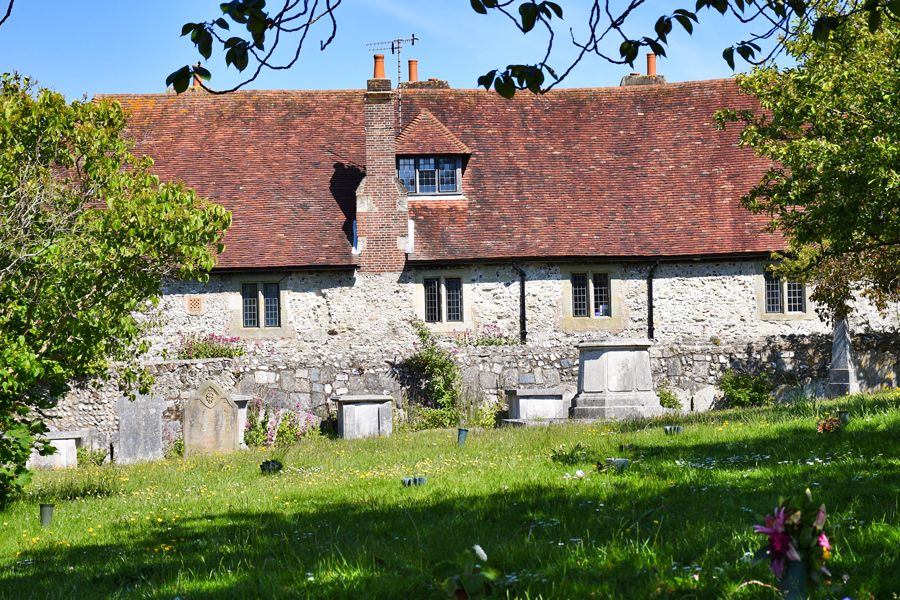
The old parsonage © French Moments
Lamb Inn
This 16th century inn retains medieval features including the mullioned upper floor, the main door and a vaulted basement with original ceiling beams. The roof is tiled.
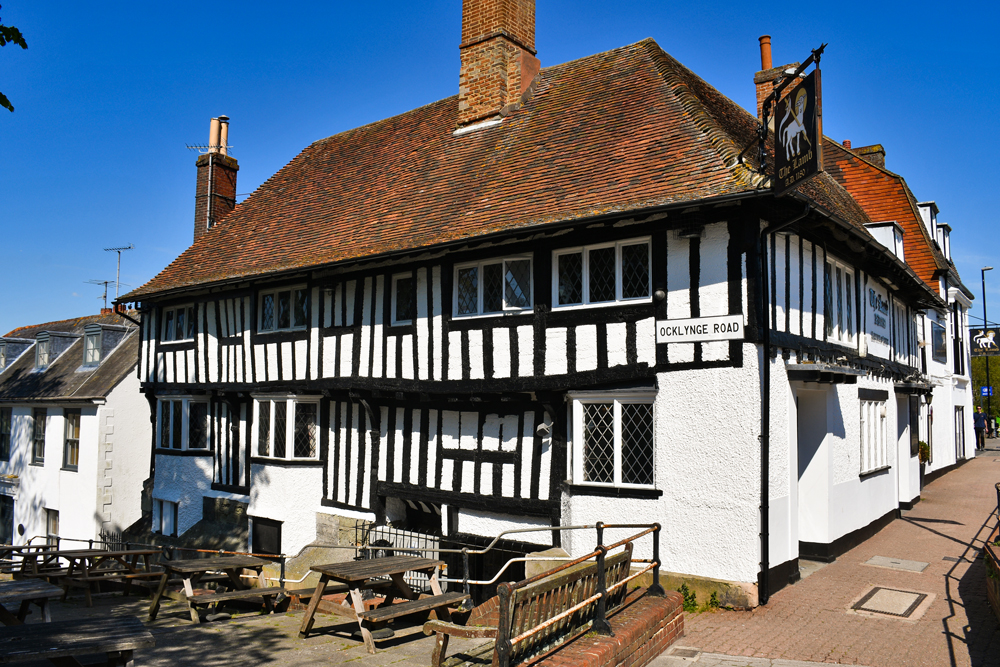
Lamb Inn © French Moments
Pilgrims House
(4 Borough Lane)
This timber-framed house with a corbelled upper floor was originally two separate buildings. Its origins date back to the 12th century.
Pilgrims House is thought to have been built by the monks of Lewes Priory as an inn along the old road that followed the south coast of England.
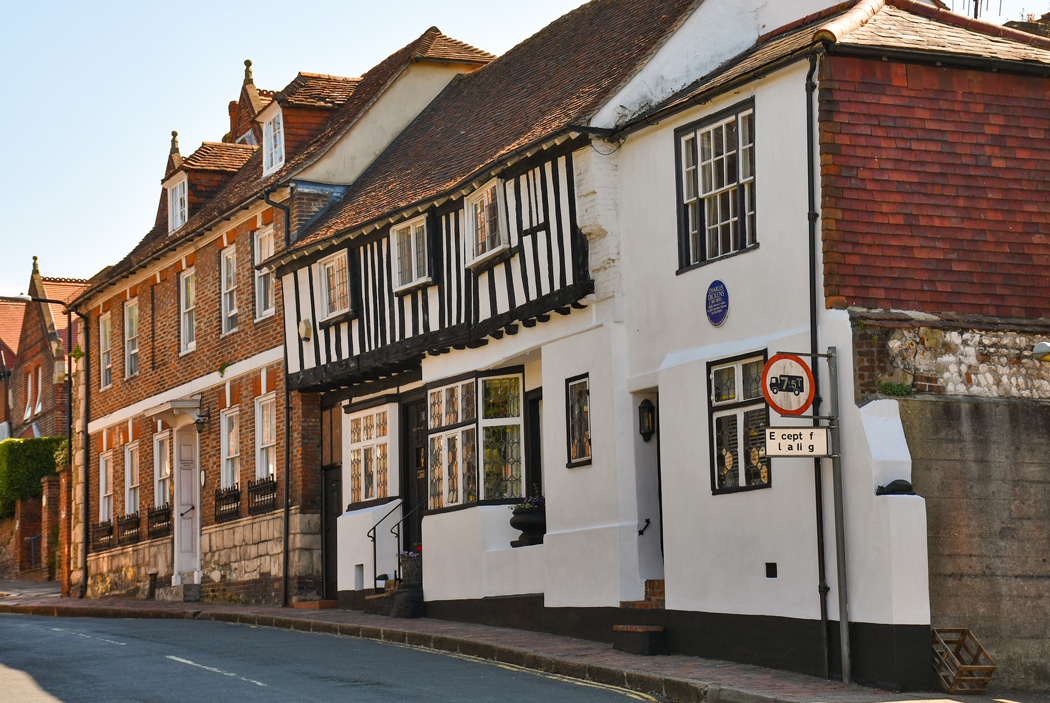
Pilgrims House © French Moments
Dickens' stays
Note the blue plaque on the house which indicates that Charles Dickens stayed there several times in the 1830s to escape London.
It was rented for several summers by the Victorian artist Augustus Egg, a close friend of Dickens.
It is said that there are secret underground passages that connect Pilgrims House to St. Mary's parish church and the Lamb Inn.
Gildredge Manor House
Gildredge Manor has been extensively and frequently remodelled since the 17th century. However, it retains some medieval features. The facade is rendered and the hipped roof is tiled and slated. Some 'rather crude' Renaissance wall paintings were discovered inside in 1957 when the building was converted into flats. The rear elevation of the manor house can be seen from the public park in Manor Gardens.
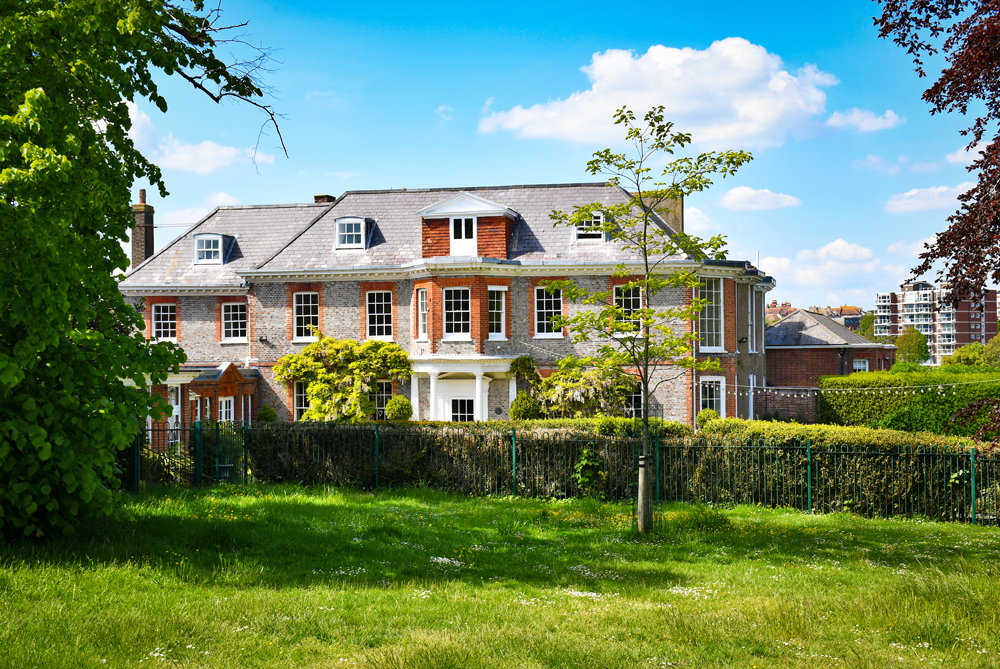
Gildredge Manor © French Moments
Manor Gardens and Gildredge Park
Gildredge Park has extensive lawns ideal for sport, recreation and picnics, a children's play area and a café.
Manor Gardens adjoins the park and forms a quieter area with a rose garden, herbaceous borders and shady lawns.
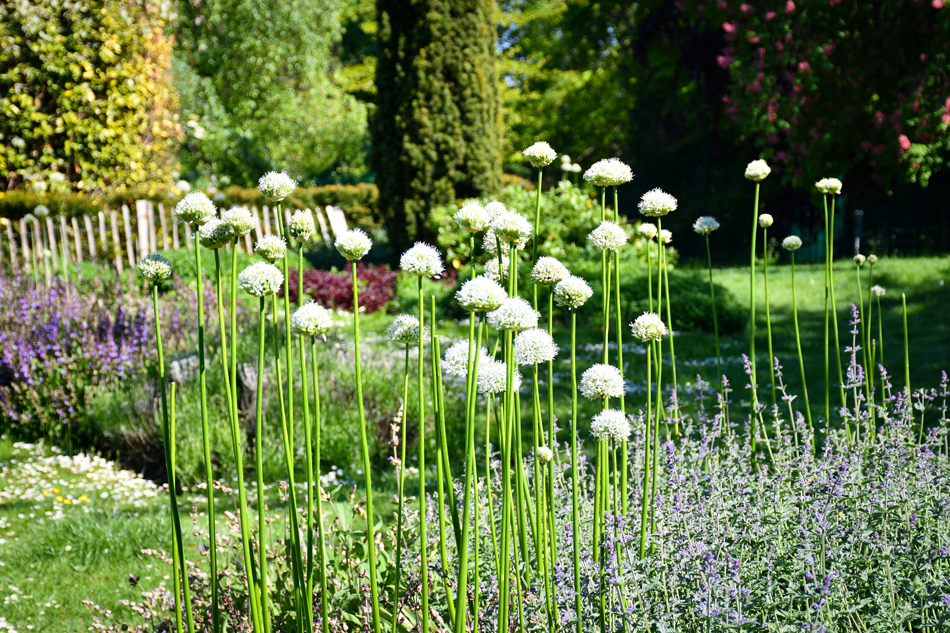
Manor Gardens © French Moments

The lawns of Gildredge Park © French Moments
The Hermitage
It is one of many listed gazebos in Eastbourne! The Hermitage is an octagonal 18th century Gothic structure set in the extensive grounds of the former Gilredge Manor. It has a rendered exterior on brickwork and a thatched roof topped with a finial. The windows on each side are set in pointed openings.
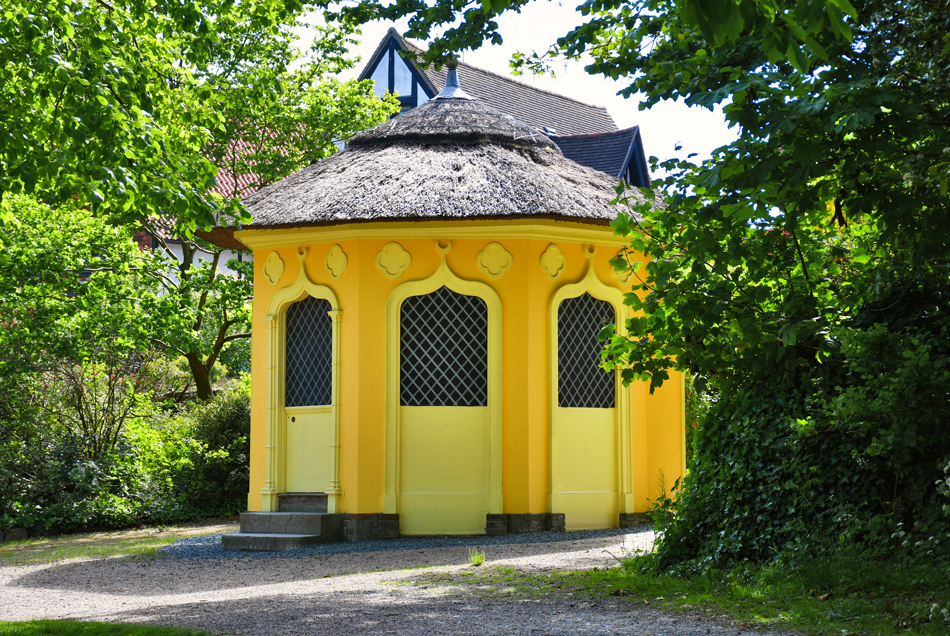
La gloriette de l'Hermitage © French Moments
Visit Eastbourne: find out more
Here are some sites to complete your visit to the English seaside resort:
- Read this page in French on our blog Destination Angleterre
- The Wikipedia page on Eastbourne
- The official website of the Eastbourne Tourist Board
- Where to stay in Eastbourne? Click here for a list of accommodation to help you plan your visit
Getting to Eastbourne
The town of Eastbourne is linked to London by the A22. The A27 follows the south coast of England westwards, linking the seaside resort to Southampton via Brighton.
- 100 km from Folkestone (Eurotunnel terminal) - approx. 1hr45 by road
- 20 km from Newhaven (Terminal Ferry) - approx. 30 min by road
- 35 km from Brighton (50 min)
- 125 km from central London (2hr10)
Continue the visit in the surroundings
Eastbourne is a great base for exploring the surrounding area in a gentle way!
Here is a list of places to visit in the area:
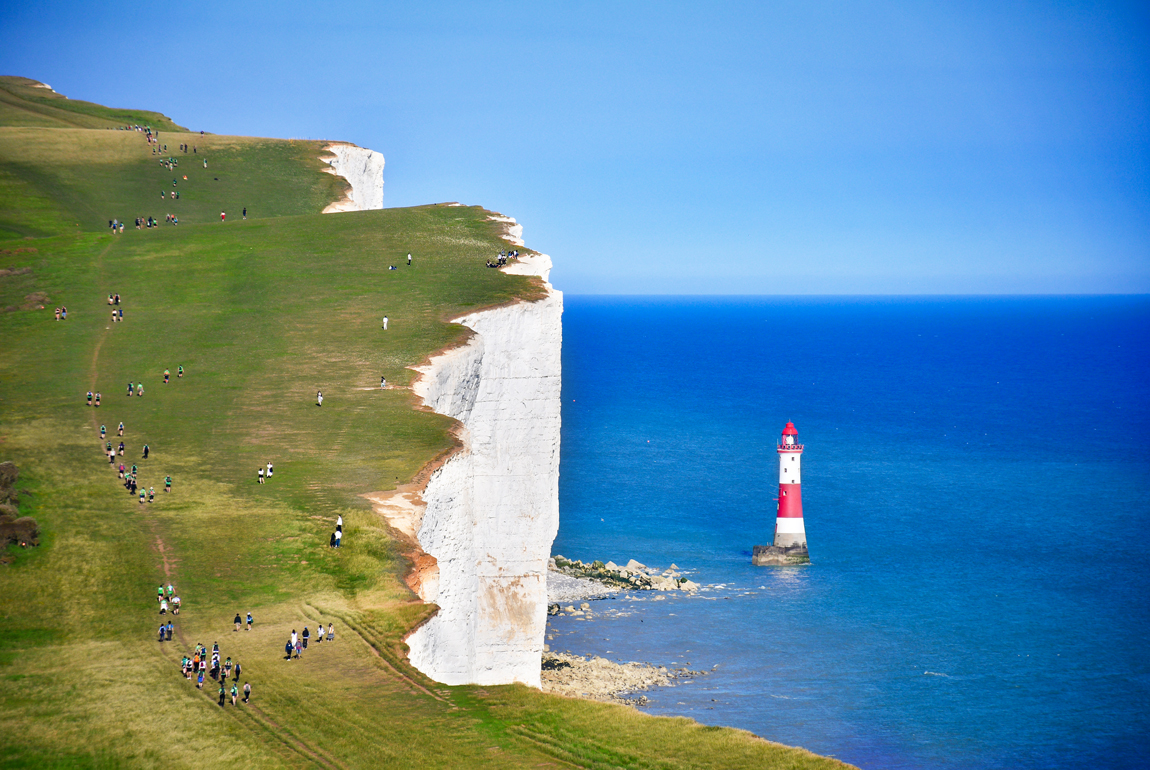
The cliffs of Beachy Head © French Moments
Did you like what you read? If so, please share this article on Facebook or Twitter! 🙂
Before we part ways, here's a pin for Pinterest so you don't forget the visit to this English seaside resort!
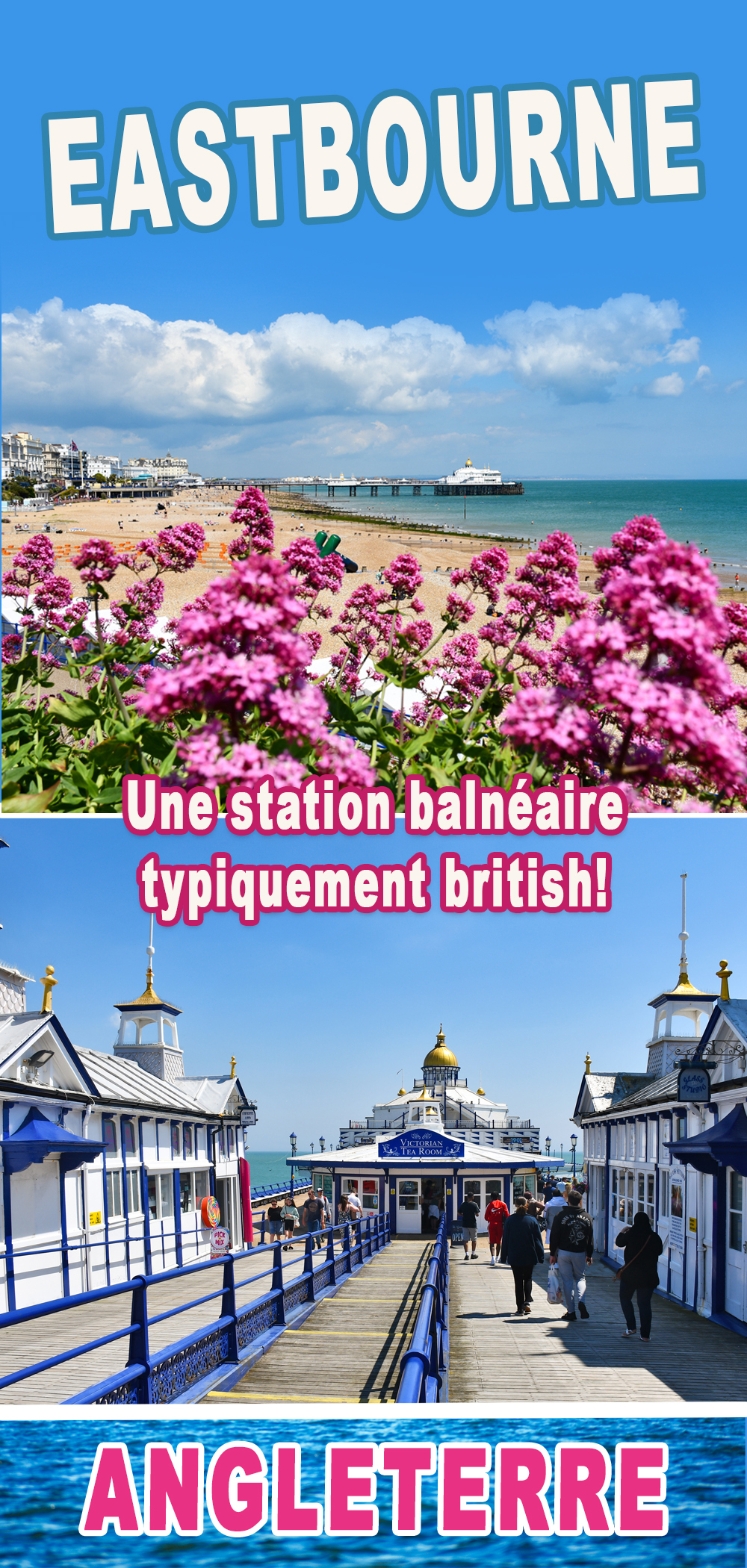

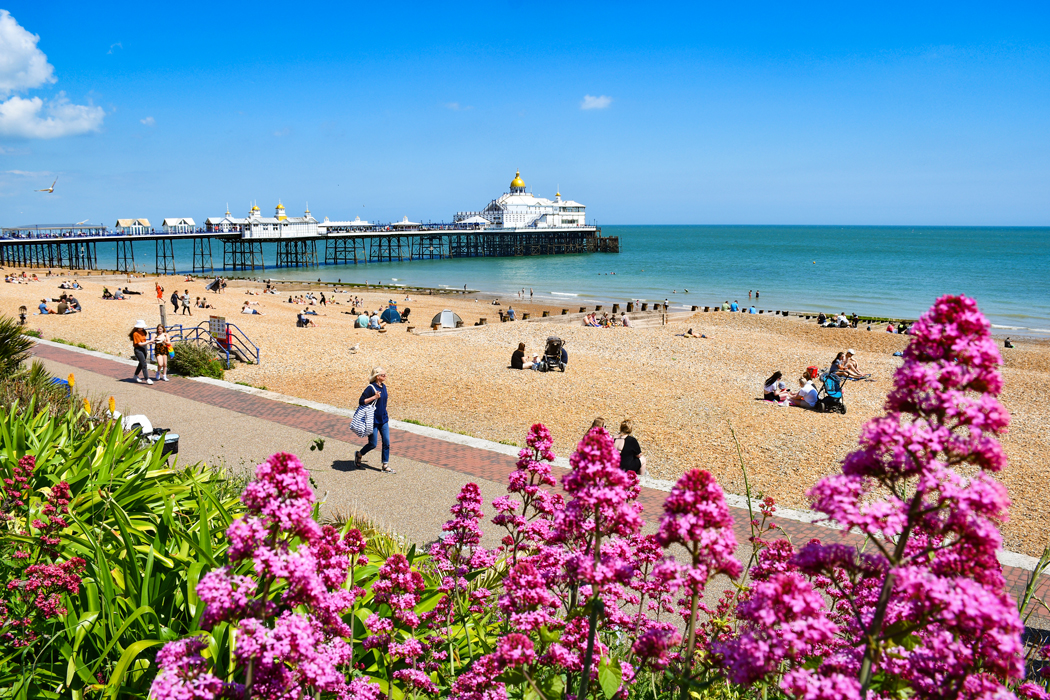

![Model of Redoubt Eastbourne © Ksimisk - licence [CC BY-SA 3.0] from Wikimedia Commons Maquette de la redoute d'Eastbourne © Ksimisk - licence [CC BY-SA 3.0] from Wikimedia Commons](https://frenchmoments.eu/wp-content/uploads/2022/04/Model-of-Redoubt-Eastbourne-©-Ksimisk-licence-CC-BY-SA-3.0-from-Wikimedia-Commons.jpg)
![Eastbourne Redoubt © Jhsteel - licence [CC BY-SA 4.0] from Wikimedia Commons Eastbourne Redoubt © Jhsteel - licence [CC BY-SA 4.0] from Wikimedia Commons](https://frenchmoments.eu/wp-content/uploads/2022/04/Eastbourne-Redoubt-©-Jhsteel-licence-CC-BY-SA-4.0-from-Wikimedia-Commons-scaled-1.jpg)
![Eastbourne Pier on fire 30 July 2014 © Rowan Stanfield - licence [CC BY 2.0] from Wikimedia Commons Eastbourne Pier on fire 30 July 2014 © Rowan Stanfield - licence [CC BY 2.0] from Wikimedia Commons](https://frenchmoments.eu/wp-content/uploads/2022/04/Eastbourne-Pier-on-fire-30-July-2014-©-Rowan-Stanfield-licence-CC-BY-2.0-from-Wikimedia-Commons-scaled-1.jpg)

